South West England
South West England | |
|---|---|
From top, left to right:Clifton Suspension BridgeinBristol;theCotswolds;Stonehenge;Newquay;Bath;Dartmoor;Torquay;Durdle Door | |
 South West England, highlighted in red on a beige political map of England | |
| Coordinates:50°58′N3°13′W/ 50.96°N 3.22°W | |
| Sovereign state | United Kingdom |
| Country | England |
| Combined authorities | West of England |
| Districts | |
| Counties | |
| Government | |
| • Type | Local authority leaders' board |
| • Body | South West Councils |
| •House of Commons | 55 MPs(of 650) |
| Area | |
| • Total | 9,415 sq mi (24,386 km2) |
| • Land | 9,203 sq mi (23,836 km2) |
| • Water | 5 sq mi (14 km2) |
| • Rank | 1st |
| Population (2021)[2] | |
| • Total | 5,712,840 |
| • Rank | 6th |
| • Density | 600/sq mi (240/km2) |
| Ethnicity(2021) | |
| •Ethnic groups | |
| Religion(2021) | |
| •Religion | List
|
| GSS code | E12000009 |
| ITL code | TLK |
| GVA | 2021 estimate[4] |
| • Total | £149.8 billion |
| • Rank | 5th |
| • Per capita | £26,219 |
| • Rank | 5th |
| GDP(nominal) | 2021 estimate[5] |
| • Total | £169.3 billion |
| • Rank | 5th |
| • Per capita | £29,628 |
| • Rank | 5th |
South West England,or theSouth West of England,is one of the nine officialregionsofEnglandin theUnited Kingdom.It consists of the counties ofCornwall(including theIsles of Scilly),Dorset,Devon,Gloucestershire,SomersetandWiltshire.Cities and large towns in the region includeBath,Bristol,Bournemouth,Cheltenham,Exeter,Gloucester,PlymouthandSwindon.It is geographically the largest of the nine regions of England with a land area of 9,203 square miles (23,836 km2), but the third-least populous, with approximately 5.7 million residents.[1][2]
The region includes theWest Countryand much of the ancient kingdom ofWessex.It includes two entirenational parks,DartmoorandExmoor(a small part of theNew Forestis also within the region); and fourWorld Heritage Sites:Stonehenge,theCornwall and West Devon Mining Landscape,theJurassic Coastand theCity of Bath.The northern part of Gloucestershire, nearChipping Campden,is as close to the Scottish border as it is to the tip of Cornwall.[6]The region has by far the longest coastline of any English region.
Following the abolition of theSouth West Regional Assemblyin 2008 andGovernment Officein 2011,South West Councilsprovide local government coordination in the region.Bristol,South Gloucestershire,andBath and North East Somersetare part of theWest of England Combined Authority.
The region is known for its richfolklore,including the legend ofKing ArthurandGlastonbury Tor,as well as its traditions and customs. Cornwall has its own language,Cornish,and some regard it as aCeltic nation.The South West is known forCheddar cheese,which originated in theSomersetvillage ofCheddar;Devoncream teas,crabs,Cornish pasties,andcider.It is home to theEden Project,Aardman Animations,theGlastonbury Festival,theBristol International Balloon Fiesta,trip hopmusic and Cornwall'ssurfingbeaches. The region has also been home to some of Britain's most renowned writers, includingDaphne du Maurier,Agatha ChristieandEnid Blyton,all of whom set many of their works here, and the South West is also the location ofThomas Hardy's Wessex,the setting for many of his best-known novels.
Geography
[edit]| This article is part ofa serieswithin the Politics of the United Kingdomon the |
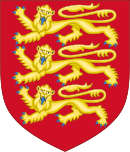 |
|---|

Geology and landscape
[edit]Most of the region is located on theSouth West Peninsula,between theEnglish ChannelandBristol Channel.It has the longest coastline of all the English regions, totalling over 700 miles (1,130 km).[7]Much of the coast is now protected from further substantial development because of its environmental importance, which contributes to the region's attractiveness to tourists and residents.
Geologically the region is divided into the largelyigneousandmetamorphicwest andsedimentaryeast, the dividing line slightly to the west of theRiver Exe.[8]Cornwall and West Devon's landscape is of rocky coastline and high moorland, notably atBodmin MoorandDartmoor.These are due to thegraniteandslatethat underlie the area. The highest point of the region isHigh Willhays,at 2,038 feet (621 m), onDartmoor.[9]In North Devon the slates of the west and limestones of the east meet atExmoorNational Park. The variety of rocks of similar ages seen has led to the county's name being given to that of theDevonianperiod.
The east of the region is characterised by wide, flat clayvales,andchalkandlimestonedownland.The vales, with good irrigation, are home to the region's dairy agriculture. TheBlackmore ValewasThomas Hardy's "Vale of the Little Dairies";[10]another, theSomerset Levelswas created by reclaiming wetlands.[11]TheSouthern England Chalk Formationextends into the region, creating a series of high, sparsely populated and archaeologically rich downs, most famouslySalisbury Plain,but alsoCranborne Chase,theDorset Downsand thePurbeck Hills.These downs are the principal area ofarable agriculturein the region. Limestone is also found in the region, at theCotswolds,Quantock HillsandMendip Hills,where they support sheep farming.[12]All of the principal rock types can be seen on theJurassic Coastof Dorset and East Devon, where they document the entireMesozoicera from west to east.[13]
Climate
[edit]The climate of South West England is classed asoceanic(Cfb) according to theKöppen climate classification.The oceanic climate typically experiences cool winters with warmer summers and precipitation all year round, with more experienced in winter. Annual rainfall is about 1,000 millimetres (39 in) and up to 2,000 millimetres (79 in) on higher ground.[14]Summer maxima averages range from 18 °C (64 °F) to 22 °C (72 °F) and winter minimum averages range from 1 °C (34 °F) to 4 °C (39 °F) across the south-west.[14]It is the second windiest area of the United Kingdom, the majority of winds coming from the south-west and north-east.[14]Government organisations predict the region to rise in temperature and become the hottest region in the United Kingdom.[15]
Inland areas of low altitude experience the least amount of precipitation. They experience the highest summer maxima temperatures, but winter minima are colder than the coast. Snowfalls are more frequent in comparison to the coast, but less so in comparison to higher ground.[14]It experiences the lowest wind speeds and sunshine total in between that of the coast and the moors. The climate of inland areas is more noticeable the further north-east into the region.
In comparison to inland areas, the coast experiences high minimum temperatures, especially in winter, and it experiences slightly lower maximum temperatures during the summer. Rainfall is the lowest at the coast and snowfall is rarer than the rest of the region. Coastal areas are the windiest parts of the peninsula and they receive the most sunshine. The general coastal climate is more typical the further south-west into the region.
Areas ofmoorlandinland such as:Bodmin Moor,DartmoorandExmoorexperience lower temperatures and more precipitation than the rest of the southwest (approximately twice as much rainfall as lowland areas), because of their high altitude. Both of these factors also cause it to experience the highest levels of snowfall and the lowest levels of sunshine. Exposed areas of the moors are windier than lowlands and can be almost as windy as the coast.
Regional identity
[edit]The boundaries of the South West region are based upon those devised by central government in the 1930s for civil defence administration and subsequently used for various statistical analyses. The region is also similar to that used in the 17th-centuryRule of the Major-GeneralsunderCromwell.(For further information, seeHistorical and alternative regions of England). By the 1960s, the South West region (including Dorset, which for some previous purposes had been included in a Southern region), was widely recognised for government administration and statistics. The boundaries were carried forward into the 1990s when regional administrations were formally established as Government Office Regions. Aregional assemblyandregional development agencywere created in 1999, then abolished in 2008 and 2012 respectively.
It has been argued[by whom?]that the official South West region does not possess a cultural and historic unity or identity of itself, which has led to criticism of it as an "artificial" construct. The large area of the region, stretching as it does from the Isles of Scilly to Gloucestershire, encompasses diverse areas which have little more in common with each other than they do with other areas of England. The region has several TV stations and newspapers based in different areas, and no single acknowledged regional "capital". Many people in the region have some level of a "South West" or "West Country" regional identity, although this may not necessarily correspond to an identification with the official government-definedregion.It is common for people in the region to identify at a national level (whetherEnglish,British,Cornishor a county, city or town level). Identifying as being from 'the Westcountry', amorphous though it is, tends to be more predominant further into the peninsula where the status of being from the region is less equivocal.[16][17]
In particular,Cornwall's inclusion in the region is disputed by Cornish nationalists.[18]The cross-partyCornish Constitutional Conventionand Cornish nationalist partyMebyon Kernowhave campaigned for aCornish Assemblyever since the idea of regional devolution was put forward.
Settlements
[edit]The South West region is largely rural, with small towns and villages; a higher proportion of people live in such areas than in any other English region. There are two major regional cities in terms of population, which are Bristol and Plymouth (although Bristol is larger by some consideration), and two major conurbations which are the South East Dorset Conurbation (Bournemouth, Christchurch and Poole) and the Bristol Metropolitan Conurbation (which includes the City of Bristol and areas of South Gloucestershire).
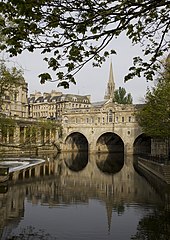
Cities and Towns with specific tourist and cultural sites of interest include Bath, Bristol, Salisbury, Plymouth, Exeter, Cheltenham, Gloucester and Weston-super-Mare, as well as the county of Cornwall on a widespread scale.
The region is home to six universities: University of Bristol, University of The West of England (UWE), University of Exeter, University of Plymouth, Plymouth Marjon University, University of Gloucestershire (Gloucester and Cheltenham), and Falmouth University (Cornwall).

The largest cities and towns in order of population are: Bristol (700,000) Plymouth (300,000) Bournemouth (250,000) Swindon (230,000) Poole (180,000) Gloucester (180,000) Exeter (160,000) Cheltenham (150,000) Torbay (150,000) Bath (130,000) Weston-super-Mare (80,000) Taunton (70,000) Salisbury (50,000) Weymouth (50,000).
The largest conurbations are the area sometimes calledGreater Bristol,which includes parts ofSouth Gloucestershire;and theSouth East Dorset conurbation,covering Bournemouth, Poole andChristchurch.
The population of the South West in 2009 was about five million.[19]
Transport
[edit]The region lies onseveral main line railways.TheGreat Western Main Lineruns fromLondon PaddingtontoBristol,Exeter,Plymouth,andPenzancein the far west of Cornwall. TheSouth West Main Lineruns fromLondon WaterlooandSouthamptontoBournemouth,PooleandWeymouthin Dorset. TheWest of England Main Lineruns from London Waterloo to Exeter via south Wiltshire, north Dorset and south Somerset. TheWessex Main Lineruns from Bristol toSalisburyand on to Southampton. TheHeart of Wessex Lineruns from Bristol in the north of the region to Weymouth on the southDorsetcoast viaWestbury,Castle CaryandYeovil,with most services starting atGloucester.
The vast majority of trains in the region are operated byCrossCountry,Great Western Railway(GWR) andSouth Western Railway(SWR). GWR is the key operator for all counties in the region except Dorset where SWR is the key operator.
CrossCountry operates services toManchester Piccadilly,GlasgowandAberdeen.Dorset is currently the only county in the region where there are electric trains, though the Great Western Main Line and theSouth Wales Main Linein Wiltshire, Somerset, Greater Bristol and Gloucestershire isbeing electrified. SWR operate services to and from London Waterloo and serves every county in the region except Gloucestershire and Cornwall. GWR serves all counties in the region and operate to various destinations, some of which run to South Wales and the West Midlands, though almost all intercity trains operated by GWR run through the region.
Transport for Walesalso operates services betweenMaestegandCheltenham Spa.West Midlands Railwayoperated aparliamentary trainbetweenBirmingham New StreetandGloucesterviaWorcester Shrub Hill,which was withdrawn in 2019 (there was once a regular service on the route, but this was withdrawn in 2009).
It has been proposed that the formerLondon & South Western RailwayExeter to Plymouth railwaybe reopened to connect Cornwall and Plymouth as an alternative to the route via theDawlishseawall that is susceptible to closure in bad weather.[20][21][22][23]
Local bus services are primarily operated byFirstGroup,Go-Ahead GroupandStagecoachsubsidiaries as well as independent operators.MegabusandNational Expressoperate long-distance services from South West England to all parts of the United Kingdom.
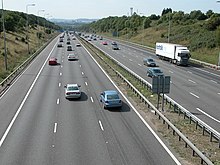
Three major roads enter the region from the east. TheM4 motorwayfrom London to South Wales via Bristol is the busiest. TheA303cuts through the centre of the region from Salisbury toHoniton,where it merges with theA30to continue past Exeter to the west of Cornwall. TheA31,an extension of theM27,serves Poole and Bournemouth and the Dorset coast. TheM5runs from theWest Midlandsthrough Gloucestershire, Bristol and Somerset to Exeter. TheA38serves as a western extension to Plymouth. There are three other smaller motorways in the region, allin the Bristol area.
Passenger airports in the region includeBristol,Exeter,NewquayandBournemouth.
Within the region the local transport authorities carry out transport planning through the use of aLocal Transport Plan (LTP)which outlines their strategies, policies and implementation programme.[24]The most recent LTP is that for the period 2006–11. In the South West region the following transport authorities have published their LTP online:BournemouthU.A.,[25]CornwallU.A.,[26]Devon,[27]Dorset,[28]Gloucestershire,[29]PlymouthU.A.,[30]Somerset,[31]SwindonU. A.,[32]TorbayU. A.[33]andWiltshire unitary authority.[34]The transport authorities ofBath and North East SomersetU. A.,BristolU. A.,North SomersetU. A. andSouth GloucestershireU. A. publish a single Joint Local Transport Plan as part of theWest of England Partnership.[35]
History
[edit]Pre-Roman
[edit]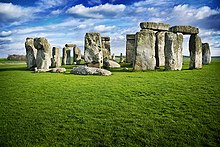
There is evidence fromflintartefactsin a quarry atWestbury-sub-Mendipthat an ancestor of modern man, possiblyHomo heidelbergensis,was present in the future Somerset from around 500,000 years ago.[36]There is some evidence of human occupation of southern England before thelast ice age,such as atKents Cavernin Devon, but largely in thesouth east.The British mainland was connected to the continent during the ice age and humans may have repeatedly migrated into and out of the region as the climate fluctuated. There is evidence of human habitation in the caves atCheddar Gorge11,000–10,000 years BC, during a partial thaw in the ice age. The earliest scientifically dated cemetery inGreat Britainwas found atAveline's Holein theMendip Hills.The human bone fragments it contained, from about 21 different individuals, are thought to be roughly between 10,200 and 10,400 years old.[37]During this time the tundra gave way tobirchforests andgrasslandand evidence for human settlement appears atSalisbury Plain,Wiltshire andHengistbury Head,Dorset.
At the end of thelast Ice AgetheBristol Channelwas dry land, but subsequently the sea level rose, resulting in major coastal changes. TheSomerset Levelswere flooded, but thedry pointssuch asGlastonburyandBrent Knollare known to have been occupied byMesolithichunters.[38]The landscape at this time wastundra.Britain's oldest complete skeleton,Cheddar Man,lived at Cheddar Gorge around 7150 BC (in theUpper Palaeolithicor Old Stone Age), shortly after the end of the ice age;[39]however, it is unclear whether the region was continuously inhabited during the previous 4000 years, or if humans returned to the gorge after a final cold spell. APalaeolithicflint tool found in West Sedgemoor is the earliest indication of human presence on the Somerset Levels.[40]During the 7th millennium BC the sea level rose and flooded the valleys, so theMesolithicpeople occupied seasonal camps on the higher ground, indicated by scatters of flints.[40]TheNeolithicpeople continued to exploit the reed swamps for their natural resources and started to construct wooden trackways. These included thePost Trackand theSweet Track.The Sweet Track, dating from the 39th century BC, is thought to be the world's oldesttimber trackwayand was once thought to be the world's oldest engineered roadway.[11]The Levels were also the location of theGlastonbury Lake Villageas well as two lake villages atMeare.[41]Stonehenge,AveburyandStanton Dreware perhaps the most famous Neolithic sites in the UK.
The region was heavily populated during the Neolithic,Bronze AgeandIron Ageperiods. Many monuments, barrows and trackways exist. Coin evidence shows that the region was split between theDurotriges,DobunniandDumnonii.The Iron Age tribe in Dorset were the Durotriges, "water dwellers", whose main settlement is represented byMaiden Castle.Ptolemystated thatBathwas in the territory of theBelgae,[42]but this may be a mistake.[43]The Celtic gods were worshipped at the temple ofSulisatBathand possibly the temple onBrean Down.Iron Age sites on theQuantock Hillsinclude majorhill fortsatDowsboroughandRuborough,as well as smaller earthwork enclosures, such asTrendle Ring,Elworthy BarrowsandPlainsfield Camp.
At the time of theRoman invasion,the inhabitants of the entire area spoke aBrythonic Celticlanguage. Its descendant languages are still spoken to a greater or lesser extent inCornwall,Wales, andBrittany.[44]
Roman period
[edit]
During theRoman era,the east of the region, particularly the Cotswolds and eastern Somerset, was heavily Romanised but Devon and Cornwall were much less so, though Exeter was a regional capital. There are villas, farms and temples dating from the period, including the remains at Bath.
The area ofSomersetwas part of theRoman Empirefrom AD 47 to about AD 409.[45]The empire disintegrated gradually, and elements ofRomanitaslingered on for perhaps a century. In AD 47, Somerset was invaded from the south-east by theSecond LegionAugusta,under the future emperorVespasian.Thehillfortsof theDurotrigesatHam HillandCadbury Castlewere captured. Ham Hill probably had a temporary Roman occupation. The massacre at Cadbury Castle seems to have been associated with the laterBoudiccan Revoltof AD 60–61.[38]
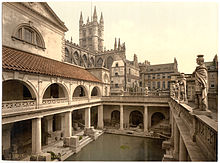
The Roman invasion, and possibly the preceding period of involvement in the internal affairs of the south of England, was inspired in part by the lead mines of theMendip Hills,which also offered the potential for the extraction of silver.[46][47]Forts were set up atBathandIlchester.The lead and silverminesatCharterhousein the Mendip Hills were run by the military. The Romans established a defensive boundary along the new military road known theFosse Way(from the Latinfossameaning "ditch" ). The Fosse Way ran throughBath,Shepton Mallet,Ilchesterand south-west towardsAxminster.The road fromDorchesterran throughYeovilto meet the Fosse Way at Ilchester. Salt was produced on theSomerset LevelsnearHighbridgeandquarryingtook place near Bath, named after theRoman baths.[48]
Excavations carried out before the flooding ofChew Valley Lakealso uncovered Roman remains, indicating agricultural and industrial activity from the second half of the 1st century until the 3rd century AD. The finds included a moderately largevillaat Chew Park,[49]where wooden writing tablets (the first in the UK) with ink writing were found. There is also evidence from thePagans Hill Roman TempleatChew Stoke.[49][50]In October 2001 theWest Bagborough Hoardof 4th-century Roman silver was discovered inWest Bagborough.The 681 coins included twodenariifrom the early 2nd century and 8miliarensiaand 671siliquaeall dating from AD 337 to 367. The majority were struck in the reigns of emperorsConstantius IIandJulianand derive from a range of mints includingArlesandLyonsin France,Trierin Germany, and Rome.[51]In April 2010, theFrome Hoard,one of the largest ever hoards of Roman coins discovered in Britain, was found by a metal detectorist. The hoard of 52,500 coins dated from the 3rd century AD and was found buried in a field nearFrome,in a jar 14 inches (36 cm) below the surface.[52]The coins were excavated by archaeologists from thePortable Antiquities Scheme.[53]
British kingdoms and the arrival of the Saxons
[edit]
After the Romans left at the start of the 5th century AD, the region split into several Brittonic kingdoms, includingDumnonia,centred around the old tribal territory of theDumnonii.[54]The upper Thames area soon came underAnglo-Saxoncontrol but the remainder of the region was in British control until the 6th century.[55][56]Bokerley Dyke,a large defensive ditch onCranborne Chasedated to 367, delayed theSaxonconquest of Dorset, with the Romano-British remaining in Dorset for 200 years after the withdrawal of the Roman legions. The WesternWandsdykeearthwork was probably built during the 5th or 6th century. This area became the border between theRomano-BritishCeltsand theWest Saxonsfollowing theBattle of Deorhamin 577.[57]
The Anglo-Saxons then gained control of the Cotswold area; but most of Somerset, Dorset and Devon (as well as Cornwall) remained in British hands until the late 7th century. According to theAnglo-Saxon Chronicle,the SaxonCenwalhachieved a breakthrough against theBritishCeltic tribes, with victories atBradford-on-Avon(in theAvon Gapin the Wansdyke) in 652,[58]and further south at theBattle of Peonnum(atPenselwood) in 658,[59]followed by an advance west through thePolden Hillsto theRiver Parrett.[60]The Saxon advance from the east seems to have been halted by battles between the British and Saxons, for example at the siege of BadonMons Badonicus(which may have been in the Bath district, perhaps atSolsbury Hill),[61]orBathampton Down.[62]The Battle ofBedwynwas fought in 675 betweenEscuin,aWest Saxonnobleman who had seized the throne ofQueen Saxburga,andKing WulfhereofMercia.[63]The earliest fortification ofTauntonstarted for KingIne of WessexandÆthelburg,in or about the year 710. However, according to theAnglo-Saxon Chroniclethis was destroyed 12 years later.[64]Alfred the Greatrefortified Exeter as a defensiveburh,followed by new erections atLydford,HalwellandPilton,although these fortifications were small compared toburhsfurther east, suggesting that they were protection for the elite only.
9th century and the arrival of the Danes
[edit]The English defeated a combined Cornish and Danish force atHingston Down(near Gunnislake) in 838.[65]Edward the Elderbuilt similarly atBarnstapleandTotnes.But sporadic Viking incursions continued until theNorman Conquest,including the disastrous defeat of the Devonians at theBattle of Pinhoe.In 876 King Alfred the Great trapped a Danish fleet atArneand then drove it out; 120 ships were wrecked atStudland.[66]Although King Alfred had lands in Cornwall, it continued to have a British king. It is generally considered that Cornwall came fully under the dominion of the English Crown in the time ofAthelstan's rule, i.e. 924–939.[67]In the absence of any specific documentation to record this event, supporters of Cornwall's English status presume that it then became part of England. However, in 944, within a mere five years of Athelstan's death,King Edmundissued a charter styling himself "King of the Englishand ruler of this province of the Britons".Thus we can see that then the" province "was a territorial possession, which has long claimed a special relationship to the English Crown.[68]

Corfe Castlein 978 saw the murder of KingEdward the Martyr,whose body was taken first toWarehamand then toShaftesbury.Somerset played an important part in stopping the spread of the Danes in the 9th century.Vikingraids took place for instance in 987 and 997 atWatchet[69]and theBattle of Cynwit.
King Alfred was driven to seek refuge from the Danes atAthelneybefore defeating them in 878 at theBattle of Ethandun,usually considered to be nearEdington, Wiltshire,but possibly the village ofEdingtonin Somerset. Alfred established a series of forts and lookout posts linked by a military road, orHerepath,to allow his army to cover Viking movements at sea. The Herepath has a characteristic form which is familiar on the Quantocks: a regulation 20 m wide track between avenues of trees growing fromhedge layingembankments. A peace treaty with the Danes was signed atWedmoreand the Danish kingGuthrum the Oldwas baptised atAller.Burhs(fortified places) had been set up by 919, such asLyng.TheAlfred Jewel,an object about 2.5-inch (64 mm) long, made of filigree gold,cloisonné-enamelled and with a rock crystal covering, was found in 1693 atPetherton Park,North Petherton.[70]This is believed to have been owned by King Alfred.[71]Monasteriesandminsterchurches were set up all over Somerset, with daughter churches of the minsters in manors. There was a royal palace atCheddar,which was used at times in the 10th century to host theWitenagemot.[72]
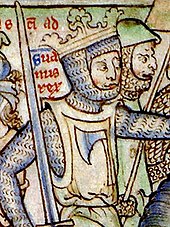
11th century
[edit]In the late pre-Norman period, the east coast of modern-day England came under the growing sway of theNorsemen.Eventually England came to be ruled by Norse monarchs, and theAnglo-Saxonkingdoms fell one by one,Wessexbeing conquered in 1013 by KingSweyn Forkbeard.[73][74][75]Sweyn's realms includedDenmarkandNorway,and parts of England such asMercia(an Anglian kingdom roughly coinciding with theEnglish Midlands), much of which, along with northern England, fell under theDanelaw.Sweyn ruled Wessex, along with his other realms, from 1013 onwards, followed by his sonCanute the Great.But Cornwall wasnotpart of his realm of Wessex. A map by the American historian called "The Dominions of Canute" (pictured just above) shows that Cornwall, like Wales and Scotland, was part neither of Sweyn Forkbeard's nor of Canute's Danish empire. Neither Sweyn Forkbeard nor Canute conquered or controlled Scotland, Wales or Cornwall; but these areas were "client nations": subject to payment of a yearly tribute ordanegeldto Sweyn and later Canute, all three areas retained their autonomy from the Danes. Ultimately, the Danes lost control of Wessex in 1042 on the death of both of Canute's sons.Edward the Confessorretook Wessex for the Saxons.[76]In 1016Edmund Ironsidewas crowned king at Glastonbury.[77]
Middle Ages
[edit]
After the Norman Conquest the region was controlled by various Norman as well asBretonlords and later by local gentry, a few of whom appear to have been descended from pre-Conquest families. In 1140, during thecivil warofKing Stephen's reign, the castles of Plympton andExeterwere held against the king byBaldwin de Redversand this gave rise to the defensive castles atCorfe Castle,Powerstock,WarehamandShaftesbury.The period saw the growth of towns such asTruro,Totnes,OkehamptonandPlymptonin the west of the region, but these were small compared with the established wealth of ancientcathedral citiesin the east of the region such asExeter,BathandWells.Wealth grew from sheep farming in the east of the region: church controlled estates such asGlastonbury AbbeyandWellsbecame among the richest in England, whiletinand silver mining was important in Devon and Cornwall;Stannary Parliamentswith semi-autonomous powers were established. Farming prospered until it was severely hit by theBlack Deathwhich arrived inDorsetin 1348 and quickly spread through Somerset, causing widespread death, with mortality rates perhaps as high as 50% in places. The resulting labour shortage led to changes in feudal practices. Crafts and industries also flourished; the Somerset woollen industry was then one of the largest in England.[78]Coal mining in theMendipswas an important source of wealth whilequarryingalso took place.
Many parish churches were rebuilt in this period. Between 1107 and 1129William Giffard,the Chancellor of KingHenry I,converted the bishop's hall in Taunton intoTaunton Castle.It passed to the king in 1233[79]and in 1245 repairs were ordered to itsmotteand towers. During the 11th-centurySecond Barons' WaragainstHenry III,Bridgwater was held by the barons against the King. During theMiddle Agessheep farming for the wool trade came to dominate the economy ofExmoor.The wool was spun into thread on isolated farms and collected by merchants to be woven, fulled, dyed and finished in thriving towns such asDunster.The land started to be enclosed and from the 17th century onwards larger estates developed, leading to establishment of areas of large regular shaped fields. During this period aroyal forestand hunting ground was established, administered by the Warden. The royal forest was sold off in 1818.[80]

Where conditions were suitable, coastal villages and ports had an economy based on fishing. The larger ports such asFoweycontributed vessels to the naval enterprises of the King and were subject to attack from the French in return. Bridgwater was part of thePort of Bristoluntil the Port of Bridgwater was created in 1348,[69]covering 80 miles (130 km) of the Somerset coast line, from theDevonborder to the mouth of theRiver Axe.[81][82]Historically, the main port on the river was at Bridgwater; the river being bridged at this point, with the first bridge being constructed in 1200.[83]Quayswere built in 1424; with another quay, theLangport slip,being built in 1488 upstream of the Town Bridge.[84]InBristolthe port began to develop in the 11th century.[85]By the 12th century Bristol was an important port, handling much of England's trade with Ireland. During this period Bristol also became a centre of shipbuilding and manufacturing. Bristol was the starting point for many important voyages, notablyJohn Cabot's 1497 voyage of exploration to North America.[86]By the 14th century Bristol was one of England's three largestmedievaltowns after London, along withYorkandNorwich,with perhaps 15,000–20,000 inhabitants on the eve of theBlack Deathof 1348–49.[87] The plague resulted in a prolonged pause in the growth of Bristol's population, with numbers remaining at 10,000–12,000 through most of the 15th and 16th centuries.[88]
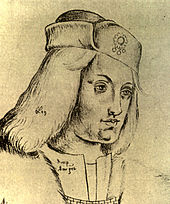
During theWars of the Roses,there were frequent skirmishes between theLancastrianThomas Courtenay, Earl of DevonandYorkistWilliam, Lord Bonville.In 1470,Edward IVpursuedRichard Neville, Earl of WarwickandGeorge, Duke of Clarenceas far as Exeter after theBattle of Lose-coat Field.The organisation of the region remained based on the shires and Church estates, which were largely unchanged throughout the period. Some of the most important nobles in the South West included the Courtenays Earl of Devon,William Bonville, 1st Baron Bonville,andHumphrey Stafford, earl of Devonwhose wider influence stretched from Cornwall to Wiltshire. After 1485, the Earl of Devon, Henry VII's chamberlain,Giles Daubeney, 1st Baron DaubeneyandRobert Willoughby, 1st Baron Willoughby de Brokewere also influential.[89]In 1497, early inHenry VII's reign, the royal pretenderPerkin Warbeck,besieged Exeter. TheCornish Rebellion of 1497led byAn GofandThomas Flamankended in a march toBlackheathin London where theCornishforces were massacred.
16th century
[edit]Great disturbances throughout both Cornwall and Devon followed the introduction ofEdward VI'sBook of Common Prayer.The day afterWhit Sunday1549, a priest atSampford Courtenaywas persuaded to read the oldmass.[90]This insubordination spread swiftly into serious revolt. The Cornish quickly joined the men of Devon in thePrayer Book Rebellionand Exeter was besieged until relieved by Lord Russell.[91]The Cornish had a particular motivation for opposing the new English language prayer book, as there were still many monoglotCornishspeakers in West Cornwall. TheCornish languagedeclined rapidly afterwards and theDissolution of the Monasteriesresulted in the eventual loss of the Cornish language as a primary language. By the end of the 18th century it was no longer a first language.
TheCouncil of the Westwas a short-lived administrative body established by Henry VIII for the government of the western counties of England. It was analogous in form to theCouncil of the North.The council was established in March 1539, withLord Russellas its Lord President. Members included Thomas Derby, Sir Piers Edgcumbe, Sir Richard Pollard and John Rowe. However, the fall ofThomas Cromwell,the chief political supporter of government by Councils, and the tranquillity of the western counties made it largely superfluous. It last sat in summer 1540, although it was never formally abolished.[92]
17th century
[edit]TheBristol Channel floods of 1607are believed to have affected large parts of theSomerset Levels,with flooding up to 8 feet (2 m) above sea level.[93][94]In 1625, a House of Correction was established inShepton Mallet,and when it closedHMP Shepton Malletwas England's oldest prison still in use.[95][96]
During theEnglish Civil War,Somerset was largelyParliamentarian,althoughDunsterwas a Royalist stronghold. The county saw important battles between theRoyalistsand the Parliamentarians, notably atLansdownein 1643 andLangportin 1645.[97]Bristol was occupied by Royalist military, after they overranRoyal Fort,the last Parliamentarian stronghold in the city.[88]Taunton Castlehad fallen into ruin by 1600 but it was repaired during the Civil War. The castle changed hands several times during 1642–45 along with the town.[98]During theSiege of Tauntonit was defended byRobert Blake,from July 1644 to July 1645. After the war, in 1662, the keep was demolished and only the base remains. This war resulted in castles being slighted (destroyed to prevent their re-use).[99]

In 1685,the Duke of Monmouthled theMonmouth Rebellionin which a force partly raised in Somerset fought againstJames II.The rebels landed atLyme Regisand travelled north hoping to captureBristolandBath,Puritan soldiers damaged the west front ofWells Cathedral,tore lead from the roof to make bullets, broke the windows, smashed the organ and the furnishings, and for a time stabled their horses in the nave.[100]They were defeated in theBattle of SedgemooratWestonzoyland,the last battle fought on English soil.[101]TheBloody Assizeswhich followed saw the losers being sentenced to death ortransportation.[102]At the time of theGlorious Revolution,King James IIgathered his main forces, altogether about 19,000 men, atSalisbury,James himself arriving there on 19 November 1688. The first blood was shed at theWincanton SkirmishinSomerset.In Salisbury, James heard that some of his officers, such asEdward Hyde,had deserted, and he broke out in a nose-bleed which he took as a bad omen. His commander in chief, theEarl of Feversham,advised retreat on 23 November, and the next dayJohn Churchilldeserted to William. On 26 November, James's daughterPrincess Annedid the same, and James returned to London the same day, never again to be at the head of a serious military force in England.[103]
Modern history
[edit]Since 1650, the City ofPlymouthhas grown to become the largest city in Devon, mainly due to the naval base atDevonport.Her Majesty's Naval Base (HMNB) Devonportis one of three operating bases in the United Kingdom for theRoyal Navy.HMNB Devonport is now the largest naval base in Western Europe.[104]The largePortland Harbour,built at the end of the 19th century and protected byNothe Fortand theVerne Citadel,was for many years, including during the wars, another of the largest Royal Navy bases.
The 19th century saw improvements to roads in the region with the introduction ofturnpikesand the building of canals and railways. The usefulness of the canals was short-lived, though they have now been restored for recreation.Chardclaims to be the birthplace ofpowered flight,in 1848 when theVictorianaeronautical pioneerJohn Stringfellowfirst demonstrated that engine-powered flight was possible through his work on theAerial Steam Carriage.[105][106]North Pethertonwas the first town in England (and one of the few ever) to be lit byacetylenegas lighting.[107]

Around the 1860s, at the height of the iron and steel era, apierand a deep-waterdockwere built, atPortisheadto accommodate the large ships that had difficulty in reachingBristol Harbour.[108][109]ThePortishead power stationswere coal-fedpower stationsbuilt next to the dock. Industrial activities ceased in the dock with the closure of the power stations. The Port of Bristol Authority finally closed the dock in 1992,[110]and it has now been developed into a marina and residential area.
During theFirst World Warmany soldiers from the South West were killed, and war memorials were put up in most of the towns and villages; only a few villages escaped casualties. There were also casualties – though much fewer – during the Second World War, who were added to the memorials. Several areas were bases for troops preparing for the 1944D-Daylandings.Exercise Tiger,or Operation Tiger, was the code names for a full-scale rehearsal in 1944 for theD-Dayinvasion ofNormandy.The British Government evacuated approximately 3,000 local residents in the area ofSlapton,nowSouth Hams DistrictofDevon.[111]Some of them had never left their villages before.[112]Bristol's city centre suffered severe damage fromLuftwaffebombing during theBristol Blitzof World War II.[113]TheRoyal Ordnance FactoryROF Bridgwaterwas constructed early inWorld War IIfor theMinistry of Supply.[114]TheTaunton Stop Linewas set up to resist a potential German invasion, and the remains of itspill boxescan still be seen, as well as others along the coast.[115]
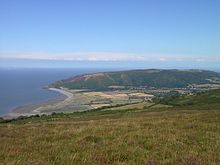
Exmoorwas one of the first British National Parks, designated in 1954, under the 1949National Parks and Access to the Countryside Act.[116]and is named after its main river. It was expanded in 1991 and in 1993 Exmoor was designated as anEnvironmentally Sensitive Area.TheQuantock Hillswere designated as anArea of Outstanding Natural Beauty(AONB) in 1956, the first such designation in England under theNational Parks and Access to the Countryside Act 1949.TheMendip Hillsfollowed with AONB designation in 1972.[117]
World War II
[edit]
Much of theBattle of the Beamswas carried out at theTelecommunications Research EstablishmentatWorth Matraversin Dorset; theH2Sradar was developed by SirBernard Lovellof Bristol. TheGloster MeteoratNewquay Air Museumis the oldest flying jet aircraft in the world.Long Ashton Research Stationin Somerset inventedRibena(for population health in World War II) and improved cider.
Scientific heritage
[edit]William Herschel,previously a clarinet player, of Bath discoveredinfraredradiation on 11 February 1800, and the planetUranusin March 1781; he had made important improvements to thereflecting telescopeby increasing the mirror diameter. Herschel then built a 20-ft reflecting telescope and invented thestar count,working out that theMilky Wayis a disc, which he called agrindstone,and that it is a galaxy. SirArthur C. ClarkeofMineheadinvented the idea of artificialsatellites;he sent a letter toHarry Wexlerwho then developed the firstweather satelliteTIROS-1.SirArthur Eddingtonof Weston-super-Mare was the first to realise thatnuclear fusionpowered the Sun; at the 1920British Associationmeeting he said that the Sun converted hydrogen into helium, although the mechanism was not known until 1933.James Bradleywas an important astronomer from Gloucestershire, who discovered theaberration of light.
Jan Ingenhousz,the Dutch biologist, discoveredphotosynthesisin 1779 atBowood Housein Wiltshire; on 1 August 1774,Joseph Priestleydiscovered oxygen there too. A fossil of the oldest ancestor of theTyrannosauruswas found in Gloucestershire;Mary Anningwas a famous fossil collector fromLyme Regis.Edward Jenner,pioneer of vaccination, was from Gloucestershire.
Industrial heritage
[edit]SirBenjamin Bakerfrom Cheltenham jointly-designed the 1890Forth Bridge.William Murdochin 1792 lit his house in Redruth with gas, the first in Britain.Plasticinewas invented 1897 in Bath byWilliam Harbutt.Thomas Youngof Somerset is known for hisdouble-slit experimentin optics, and insolid mechanicsfor his famousYoung's modulus.Henry Fox Talbot,inventor of anegative-positiveprocessin 1841, from Wiltshire made the first photograph in August 1835;Nicéphore Niépceof France can claim thefirst photoin 1826;William Friese-Greeneof Bristol is thought to be thefather of cinematographyafter inventing hischronophotographic camerain 1889.
Hinkley Point A nuclear power stationwas aMagnoxpower stationconstructed between 1957 and 1962 and operating until ceasing generation in 2000.[118]Hinkley Point Bis anAdvanced Gas-cooled Reactor(AGR) which was designed to generate 1250 MW of electricity (MWe). Construction of Hinkley Point B started in 1967. In September 2008 it was announced, byÉlectricité de France(EDF), that a third, twin-unitEuropean Pressurised Reactor(EPR) power station known asHinkley Point Cis planned,[119]to replace Hinkley Point B which was due for closure in 2016,[120]now extended until 2022. In 1989 theBerkeley nuclear power stationwas the first in the UK to be decommissioned. Thesteam-generating heavy water reactorwas developed atWinfrithin Dorset.
Ted Codd,inventor of databases andSQL,was from Poole.Campden BRIatEbringtonin north-east Gloucestershire was an important research centre forcanned food;J. S. Fry & Sonsof Bristol made world's first chocolate bar in 1847.
The firstcarpetswere made in Britain in 1741 atWilton, Wiltshire.In 1698,Thomas Saveryof Devon developed an earlysteam engine;Thomas Newcomenfrom Dartmouth made another early steam engine in 1710.Edward Butler,a farmer from Devon born inBickingtonin 1862, invented the petrol engine.
Demographics
[edit]

At the2021 census,the population of the South West region was 5,701,186[121]
It has long been one of the fastest-growing regions in England and its 2021 population had increased by 7.8% since 2011 (when it was 5,288,935), and by 15.7% over the 2001 figure (4,928,434).
At the 2021 census, the proportion of white people in the region decreased from 95.4% to 93.1%, while the proportion of black and Asian residents increased significantly. At that time, 87.8% of the region's residents were classed as White British, which was higher than the England average of 73.5%.[122]
The region had the oldestmedian agein England; in the 2011 census,West Somersethad the UK's oldest average age – almost 48. The region had the second-highest proportion (23%) of rural population in the UK, after Northern Ireland.
| Year | Pop. | ±% p.a. |
|---|---|---|
| 1801 | 1,355,811 | — |
| 1811 | 1,498,569 | +1.01% |
| 1821 | 1,754,725 | +1.59% |
| 1831 | 1,981,488 | +1.22% |
| 1841 | 2,173,157 | +0.93% |
| 1851 | 2,263,070 | +0.41% |
| 1861 | 2,319,593 | +0.25% |
| 1881 | 2,444,167 | +0.26% |
| 1891 | 2,543,186 | +0.40% |
| 1911 | 2,825,046 | +0.53% |
| 1921 | 2,877,866 | +0.19% |
| 1931 | 2,989,977 | +0.38% |
| 1951 | 3,483,675 | +0.77% |
| 1961 | 3,693,029 | +0.59% |
| 1971 | 4,132,770 | +1.13% |
| 1981 | 4,163,729 | +0.07% |
| 1991 | 4,610,241 | +1.02% |
| 2001 | 4,928,364 | +0.67% |
| 2011 | 5,288,935 | +0.71% |
| 2021 | 5,701,186 | +0.75% |
| Source: A Vision of Britain through Time[123] | ||
Ethnicity
[edit]| Ethnic group | Year | |||||||
|---|---|---|---|---|---|---|---|---|
| 1991[124] | 2001[125] | 2011[126] | 2021[127] | |||||
| Number | % | Number | % | Number | % | Number | % | |
| White:Total | 4,546,848 | 98.6% | 4,815,316 | 97.7% | 5,046,429 | 95.41% | 5,309,608 | 93.1% |
| White:British | – | – | 4,701,602 | 95.39% | 4,855,676 | 91.8% | 5,008,149 | 87.8% |
| White:Irish | – | – | 32,484 | 0.65% | 28,616 | 0.54% | 31,698 | 0.6% |
| White:Irish Traveller/Gypsy | – | – | – | – | 5,631 | 6,382 | 0.1% | |
| White: Roma | – | – | – | – | – | – | 5,785 | 0.1% |
| White:Other | – | – | 81,230 | 1.64% | 156,506 | 2.95% | 257,594 | 4.5% |
| Asian or Asian British:Total | 28,368 | 0.6% | 45,522 | 0.92% | 105,537 | 1.99% | 159,184 | 2.8% |
| Asian or Asian British:Indian | 10,915 | 16,394 | 34,188 | 58,847 | 1.0% | |||
| Asian or Asian British:Pakistani | 3,925 | 6,729 | 11,622 | 17,432 | 0.3% | |||
| Asian or Asian British:Bangladeshi | 2,308 | 4,816 | 8,416 | 12,217 | 0.2% | |||
| Asian or Asian British:Chinese | 6,687 | 12,722 | 22,243 | 26,516 | 0.5% | |||
| Asian or Asian British:Asian Other | 4,533 | 4,861 | 29,068 | 44,172 | 0.8% | |||
| Black or Black British:Total | 21,779 | 0.5% | 20,920 | 0.42% | 49,476 | 0.93% | 69,614 | 1.3% |
| Black or Black British:African | 2,820 | 6,171 | 24,226 | 43,318 | 0.8% | |||
| Black or Black British:Caribbean | 12,387 | 12,405 | 15,129 | 17,226 | 0.3% | |||
| Black or Black British:Other | 6,572 | 2,344 | 10,121 | 9,070 | 0.2% | |||
| Mixed:Total | – | – | 37,371 | 0.75% | 71,884 | 1.35% | 114,074 | 2% |
| Mixed:WhiteandCaribbean | – | – | 13,343 | 25,669 | 33,217 | 0.6% | ||
| Mixed:WhiteandAfrican | – | – | 3,917 | 8,550 | 15,644 | 0.3% | ||
| Mixed:WhiteandAsian | – | – | 11,198 | 21,410 | 34,960 | 0.6% | ||
| Mixed:Other Mixed | – | – | 8,913 | 16,255 | 30,253 | 0.5% | ||
| Other: Total | 12,429 | 0.3% | 9,305 | 0.18% | 15,609 | 0.29% | 48,706 | 0.9% |
| Other:Arab | – | – | – | – | 5,692 | 10,302 | 0.2% | |
| Other: Any other ethnic group | 12,429 | 0.3% | 9,305 | 0.18% | 9,917 | 38,404 | 0.7% | |
| Ethnic minority: Total | 62,576 | 1.4% | 113,118 | 2.3% | 242,506 | 4.6% | 391,578 | 6.9% |
| Total | 4,609,424 | 100% | 4,928,434 | 100% | 5,288,935 | 100% | 5,701,186 | 100% |
Religion
[edit]| Religion | 2021[128] | 2011[129] | 2001[130] | |||
|---|---|---|---|---|---|---|
| Number | % | Number | % | Number | % | |
| Christianity | 2,635,872 | 46.2% | 3,194,066 | 60.4% | 3,646,488 | 74.0% |
| Islam | 80,152 | 1.4% | 51,228 | 1.0% | 23,465 | 0.5% |
| Hinduism | 27,746 | 0.5% | 16,324 | 0.3% | 8,288 | 0.2% |
| Buddhism | 24,579 | 0.4% | 19,730 | 0.4% | 11,299 | 0.2% |
| Sikhism | 7,465 | 0.1% | 5,892 | 0.1% | 4,614 | 0.1% |
| Judaism | 7,387 | 0.1% | 6,365 | 0.1% | 6,747 | 0.1% |
| Other religion | 36,884 | 0.6% | 29,279 | 0.6% | 18,221 | 0.4% |
| No religion | 2,513,369 | 44.1% | 1,549,201 | 29.3% | 825,461 | 16.7% |
| Religion not stated | 367,732 | 6.5% | 416,850 | 7.9% | 383,851 | 7.8% |
| Total population | 5,701,186 | 100% | 5,288,935 | 100% | 4,928,434 | 100% |
Housing
[edit]35% of people in the region own their homes outright, with no debt, the highest in the UK. The Cotswold district had the biggest house price increases in the region, and the second-biggest in the UK outside of London and the South-East, in a March 2015 survey.Weymouth and Portlandhas the highest council tax in England. West Somerset has the lowest average full-time pay at £287; West Somerset is also the district where poor children do much worse than wealthier children at school, with some of the worst differences in the UK, according toAmbition School Leadership.
Teenage pregnancy
[edit]For top-tier authorities, Torbay has the highest teenage pregnancy rate in the region,[131]with Exeter the highest rate for council districts. For top-tier authorities, North Somerset (closely followed by Bath & NE Somerset) has the lowest rate, withCotswoldhaving the lowest rate for council districts.
Health
[edit]The population in the region with the highest obesity level isSedgemoorin Somerset, with 73.4%, the fifth in the UK.[citation needed]North Dorset has the lowest proportion of cancer deaths in England – 97 per 100,000 (the England average is 142 per 100,000), down from 162 ten years earlier.[when?]
In the 2011 census, East Dorset had the highest rate of marriage in the UK; East Dorset also has the third-highest life expectancy for men in the UK at 82.7.[citation needed]
Crime
[edit]For England and Wales in 2015,Wiltshirehas the fourth-lowest crime rate, andDevon and Cornwallhas the fifth-lowest.
Deprivation
[edit]As measured by theEnglish Indices of Deprivation 2007,the region shows similarities withSouthern Englandin having moreLower Layer Super Output Areasin the 20% leastmultiple depriveddistricts than the 20% most deprived.[132]The relative amount of deprivation is similar to theEast Midlands,except the South West has many fewer deprived areas. According to the LSOA data in 2007, the most deprived districts[133](before Cornwall became a unitary authority) were, in descending order: Bristol (64th in England), Torbay (71st), Plymouth (77th),Kerrier(86th),Restormel(89th),North Cornwall(96th), and West Somerset (106th). At county level, the deprived areas are City of Bristol (49th in England), Torbay (55th), Plymouth (58th), and Cornwall and the Isles of Scilly (69th).
The least deprived council districts are, in descending order: East Dorset, North Wiltshire, South Gloucestershire, Cotswold, Kennet, Stroud, Tewkesbury, West Wiltshire, Salisbury, and Bath and North East Somerset. At county level, the least deprived areas, in descending order, are South Gloucestershire, Wiltshire, Bath and North East Somerset, Dorset, Gloucestershire, Poole, North Somerset, and Somerset. For smaller areas, the least-deprived in the region are E01015563 (139th in England) – Shaw and Nine Elms ward, in north Swindon; E01014791 (163rd in England) – Portishead East ward, in North Somerset off the A369 inPortishead and North Weston;E01020377 (184th in England) –ColehillEast ward, in East Dorset, east of Wimborne Minster.
In March 2011, the region had the second-lowestunemployment claimantcount in England, second toSouth East England,with 2.7%. Inside the region,Torbayhas the highest rate with 4.5%, followed by Bristol and Plymouth with 3.8%. East Dorset has the lowest rate with 1.4%.[134]
Language
[edit]TheCornish languageevolved from theSouthwesterndialect of theBrittonic languagespoken during theIron AgeandRoman period.[135]The area controlled by the Britons was progressively reduced by the expansion ofWessexafter the 6th century, and in 936Athelstanset the east bank of theTamaras the boundary betweenAnglo-SaxonWessexandCelticCornwall.[136]The Cornish language continued to flourish during theMiddle Agesbut declined thereafter, and the last speaker of traditional Cornish died in the 19th century.[137]Geographical names derived from the British language are widespread in South West England, and include several examples of theRiver Avon,fromabonā= "river" (cf.Welshafon), and the words "tor"and"combe".[138]
Until the 19th century, theWest Countryand its dialects of theEnglish languagewere largely protected from outside influences, due to its relative geographical isolation. The West Country dialects derive not from a corrupted form of modern English, but from the Southwestern dialects ofMiddle English,which themselves derived from the dialects of the Anglo-Saxon kingdom ofWessex.Late West Saxon,which formed the earliest English language standard, from the time of King Alfred until the late 11th century, is the form in which the majority of Anglo-Saxon texts are preserved.Thomas Spencer Baynesclaimed in 1856 that, due to its position at the heart of the Kingdom of Wessex, the relics of Anglo-Saxon accent, idiom and vocabulary were best preserved in the Somerset dialect. There is some influence from theWelshandCornishlanguages, depending on the specific location.
West Country dialects are commonly represented as "Mummerset",a kind of catchall southernruralaccent invented for broadcasting.
Economy and industry
[edit]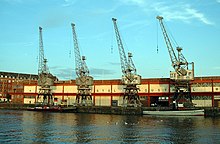

The most economically productive areas within the region are Bristol, theM4 corridorand south east Dorset, which are the areas with the best links to London. Bristol alone accounts for a quarter of the region's economy, with the surrounding areas of Gloucestershire, Somerset and Wiltshire accounting for a further quarter.[139]
Bristol's economy has been built on maritime trade, including the import of tobacco and theslave trade.Since the early 20th century, however,aeronauticshave taken over as the basis of Bristol's economy, with companies includingAirbus UK,Rolls-Royce(military division) andBAE Systems(formerBristol Aeroplane CompanythenBAC) manufacturing inFilton.Defence Equipment & Supportis atMoD Abbey Wood.More recently defence, telecommunications, information technology and electronics have been important industries in Bristol, Swindon and elsewhere. TheDriver & Vehicle Standards Agency,theSoil Association,Clerical Medical,andBristol Waterare in Bristol;Indesitmakestumble dryersinYate;HPandInfineon Technologies UKare atStoke Gifford.Knorr-Bremse UKmakeair brakesinEmersons Green.TheSouth West Observatory's Economy Module provides a detailed analysis of the region's economy.[140]
The region'sGross value added(GVA) breaks down as 69.9%service industry,28.1%production industryand 2.0% agriculture. This is a slightly higher proportion in production, and lower proportion in services, than the UK average. Agriculture, though in decline, is important in many parts of the region.Dairy farmingis especially important in Dorset and Devon, and the region has 1.76 million cattle, second to only one other UK region, and 3,520 square miles (9,117 km2) of grassland, more than any other region. Only 5.6% of the region's agriculture isarable.[139]
Tourism is important in the region, and in 2003 the tourist sector contributed £4,928 million to the region's economy.[141] In 2001 the GVA of the hotel industry was £2,200 million, and the region had 13,800 hotels with 250,000 bed spaces.[139]
There are large differences in prosperity between the eastern parts of the region and the west. While Bristol is the second most affluent large city in England after London,[142]parts of Cornwall have among the lowest average incomes in Northern Europe.

The region'sManufacturing Advisory Serviceis on theA38north of Gloucester atTwigworth,[143]and theUK Trade & Investmentoffice is at the Leigh Court Business Centre inAbbots Leigh,North Somerset.[144]
Cornwall
[edit]
Major companies in Cornwall includeImeryswho are major producers of kaolin.Rodda'smakeclotted creamnearScorrier,off the A30 east of Redruth.Fugro SeacoreinMongleathnear Falmouth are leading offshore drilling contractors;Pendennismakesluxury yachtsatFalmouth Docks.Kensa Heat Pumpsare west of Truro. Cornish Country Larder, owned by Arla, make cheese (Cornish Brie) atTrevarrianon the B3276 inMawgan-in-Pydar,north ofNewquay Airport(formerRAF St Mawgan).
Allen & Heathmakemi xing consolesinPenryn.Fourth Element(wet suits) are on the A3083 atCury,south ofRNAS Culdroseand Helston.A.P. Valvesmake diving equipment in Helston off the B3297 on Water-Ma-Trout Ind Estate, next toHelston Community College;Spiral Constructionis the UK's leading manufacturer ofspiral staircases.
Gul (clothing)(watersports clothing) are on Callywith Gate Ind Est inCookslandBodmin at the western end of the A38, on the north end of the Bodmin bypass;C-Skins(wetsuits) are on the Walker Lines Ind Est, south of Bodmin on the B3268;Fitzgerald Lightingare west of theCarminow Crossjunction.GCHQ Budeis an important radar station inMorwenstow.On the other side of the river from Devonport isHMS Raleigh,off theA374atTorpoint,home of theRoyal Navy Submarine School(moved fromHMS DolphininGosportin 1999) and itsSubmarine Command Course;it provides all the training for theRoyal Naval Reserve(RNR).

Cornwall has become reliant on tourism, more so than the other counties of the South West. In 2010 Cornwall and the Isles of Scilly had the lowest GVA per head of any county or unitary authority in England.[145]It contributes only 7.4% of the region's economy[146]and has receivedEU Convergence funding(formerly Objective One funding) since 2000.[147]Over four million people visit the county each year.[148]The reasons for Cornwall's poor economic performance are complex and apparently persistent, but causes include its remoteness and poor transport links,[139]the decline of its traditional industries, such asmining,agriculture and fishing, the low-wealth generating capacity of tourism, relocation of higher skilled jobs to other parts of the South West, and lack of a concerted economic strategy (although use of European Regional Development Fund and European Social Fund monies have been deployed in an attempt at restructuring).[149]
Devon
[edit]
TheMet Officeis inExeter,as arePennon Group,the water company,Pedigree Dolls & Toys(Sindydoll), andThrifty Car RentalUK, which is at Ashton Business Centre inSt Thomason the A377 opposite the Exeter Retail Park. The airlineFlybewas based at Exeter Airport until 2019;Plymouth City Airportclosed in 2011.Chatham Marineclothing and footwear is off the B3123 on the Marsh Barton Trading Estate, nearAlphington.Eclipse InternetandEDF Energyare in the same building south-east of the Met Office next to the M5;Stovax Group,who makewoodandgas-burning stoves,are further south on Sowton Ind Est next toAlcoa HowmetUK, who makevacuum alloyairfoilcastings for industrial gas turbines.DEFRAhave a main site for Devon atWinslade Park,to the east atClyst St Mary;nearby to the south on theA376is the HQ ofDevon & Somerset Fire & Rescue Service.DormakabaUK, at Tiverton, are a world-leader inturnstiles,revolving doorsandlocks;Heathcoat Fabricsmake theDecelAirfabric forparachutes.Taw Valley cheese is made byArla Foods UK(former Milk Link) atNorth Tawtonoff theA3124,also the HQ of Gregory Distribution.
XYZ Machine Toolsis off the A38 close to the M5 bridge inBurlescombenear the Somerset boundary.The Donkey Sanctuaryis inSidmouth.Axminster Carpetsmakes carpets for everyWetherspoonspub.[citation needed]
Appledore Shipbuildersare based atAppledore, Torridge, Devon,three miles north ofBideford,who built sections of theQueen Elizabeth-class aircraft carriers.Parker Hannifinhave their instrumentation division next to theTaw Bridge(A361) atPottingtonin Barnstaple;CQCmakes personal equipment andOsprey body armour;off the A361 towards Barnstaple, is achipboard(Conti and Caberboard) plant ofNorbord.Next toRoyal Marines Base Chivenor,PerrigomakesGermoleneand own-label OTC medicines at the Wrafton Laboratories inHeanton Punchardonon the A361.ActavisUK (former Cox Pharmaceuticals, part ofHoechst AG), off the A361 east of Barnstaple, makelevothyroxineand otherthyroid hormones.Dartington CrystalinTorringtonmakesRoyal Brierley.Pall Europemake filtration products inIlfracombe.
AllAmbrosia(former Unilever) products are made at theAmbrosia CreameryinLifton,off the A30 on theRiver Lyd.Parkham FarmsmakeWestcountry Farmhouse CheddaratWoolfardisworthy, Torridge.SC Group(Supacat) atDunkeswell Aerodrome,north ofHoniton,make protective vehicles for the Army, notably theJackal;these vehicles are also made in Plymouth byBabcock InternationalformerlyDevonport Management Limited(DML);Oceanic WorldwideUK makesscuba divinggear.Questedmake high-endloudspeakerson Heathpark Ind Est, west of Honiton, next to the railway.
Centraxmake industrial gas turbines inNewton Abbot;to the north-west, on the A38 at the A382 junction atHeathfieldinBovey Tracey,British Ceramic Tilehave the largest ceramictileplant in Europe.Suttons Seedsis inPaignton;AVX,off theA3022,was a worldwide site fortantalum capacitors,until the company moved production to the Czech Republic in 2009.Britannia Royal Naval Collegeis atDartmouth.
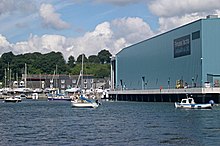
HMNB Devonport(HMS Drake, the largest naval base in western Europe) is in Plymouth.Toshibahad a large presence inErnesettle,in the north of Plymouth, which was the second-largest employer after the Royal Navy, until they moved production of televisions toKobierzycein Poland in 2009; it made its last television at the site on 27 August 2009;Vispring(beds) is next toKawasaki Precision Machinery.Snowbeemakefishing tackle.3 Commando Brigadeis atStonehouse Barracks.The Range(home and leisure) is on the B3432 inEstovereast of Plymouth Airport; opposite isFine Tubesand further eastBardenmake ball-bearings for the aerospace industry; on the furthest east of the industrial estate isWrigley CompanyUK; itsExtrabrand is the second best-selling confectionery in the UK afterDairy Milk.[citation needed]

X-FabUK (semiconductor fabrication plant,former Plessey Semiconductors) is next to theA386BickleighCross roundabout; nearbyBDhave a large plant making medicalvacutainers(for blood samples) on Belliver Way Ind Est in the north of Plymouth; south of BD off the B3373 inSouthwayis Silicon Sensing Systems (who makevibrating structure gyroscopesand are owned byUTC Aerospace Systems,previously BAE Systems, andBAe Dynamics,who had madenose conesfor aircraft including Concorde), andSchneider ElectricUK (Drayton Controls,market-leadingthermostatic radiator valvesforcentral heating,previously owned by Invensys Controls UK).
Hemerdon Mine,east of Plymouth, has one of the largest deposits oftungstenin the world.Wills Marinemake motorinflatable boatsoff theA379inKingsbridge.[citation needed]
Dorset
[edit]New Lookis inWeymouth;it is Britain's second-biggest value clothing retailer, with over 800 stores in 21 countries.Wytch Farm(BP) is the UK's largest onshore oil field.Meggittis a leading aerospace and defence contractor, based west of Bournemouth Airport, withHobbycraft,at a formerBACworks inHurn,close toWest Parley.TheRoyal Armoured Corpsis based atBovington Camp,and next door is theBovington Tank Museum;the Army has three armoured regiments (Royal Dragoon Guards,Royal Tank RegimentandKing's Royal Hussars) and 227 FV4034 70-tonneChallenger 2tanks; Germany has around 1,000 tanks and Russia has 3,300.Westwind Air Bearings(owned by Novanta) is off theA352atWareham St Martin,west of Poole, nearHolton Heath railway station,withMathmos(lighting), founded byEdward Craven Walkerwho invented thelava lamp.
Tata Consultancy Services(formerUnisys Insurance Servicesbefore 2010) is in Bournemouth.Imagine Publishing,a magazine publisher, withThe Mortgage Works(owned by Nationwide Building Society), is at theA35/A347 Richmond Hill Roundabout;Organixis in the centre;McCarthy & Stone,who make much of Britain's retirement housing, is on the B3066.LV=(insurance) is atFrizzell HouseatWestbourneat the County Gates Gyratory A35/A338 roundabout.JPMorgan Chasehave their large Chaseside site at the A3060/A338 junction opposite theRoyal Bournemouth Hospital,RIAS(insurance) andTeachers Assurance,towardsHoldenhurst.
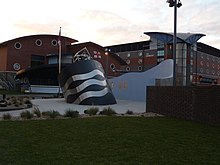
Merlin Entertainments(who ownSea Life Centres,and are the world's second largesttheme parkoperator afterDisney) is inPoolewith a former division,Aquarium Technology,at the end of the A350 near theTwin Sails bridge.Ryvitais made inParkstoneon the B3061.Fitness First,the largest privately owned health club group in the world, originated in Bournemouth and is now globally headquartered south of Fleet's Corner.Siemens Traffic Controlsmake most of the UK's traffic lights west near Fleet's Corner; the main traffic light in the UK is the Siemens Helios (the other make is thePeekElite). North of Fleets Lane, south of the Wessex Gate Retail Park, isParvalux,on the A3049 on the West Howe Ind Estate inWallisdown,which makes gearedDC electric motorsand gearboxes; further south isFaerch Plast(formerSealed Air,which makes trays for food) then Fitness First, andAeronautical & General Instruments;further north isLush,the cosmetics company, with HamworthyWärtsilä(Finnish), and Hamworthy Combustion (owned byKoch Industries), at the A349/A3049 junction inFleetsbridge,is an international engineering consultancy.
SunseekerInternational is a main motoryachtmanufacturer; it made the boat in the opening sequence ofThe World Is Not Enough.TheSpecial Boat Serviceis based atRM Poole,home of the Navy'samphibious warfaresection, off the B3068 atHamworthyin the west of Poole.Tangerine Confectionery(former Parrs) made gums and jellies on the Redlands Trading Estate off theA3040nearBranksome railway stationto the east.Aish Technologiesmakes console (display) systems for the Royal Navy off B3068 inAlderney.

Cobham plc,inWimborne MinstertowardsLeigh,is a world-leader inair-to-air refuelling,developed byAlan CobhamatRAF Tarrant Rushton,and aircraft antennas.DurableUK (office products) is in Wimborne;Caterpillar's Wimborne Marine Power Centre makePerkinsSabre marine diesel generators onFerndownInd Est off the A31; to the south is the paint manufacturerFarrow & BallinHamprestonandStapehill,in Ferndown.Manitou UK,owner of the AmericanGehl Companyand fromNanterrein France, is based atVerwoodon the Ebblake Ind Est off the B3081 near the Hampshire boundary.Sigma-AldrichUK (pharmaceuticals) are off the B3092 on Brickfield Business Park inGillingham,next to theRiver Stourand railway.Cygnus Instruments,on the B3144 in Dorchester, is the leading manufacturer ofultrasonic thicknessgauges, developing the technique in the early 1980s.Edwards Sports Productsof Bridport, owned byBroxapof Staffordshire, make football goals for thePremier League,and tennis nets and posts forWimbledon.[citation needed]
Gloucestershire
[edit]
In Cheltenham areEndsleigh InsuranceinShurdington,Kohler Mira Ltd(showers),Superdry(clothing),Collins Geo(maps), andChelsea Building Societyare on the A435 to the south-east. North of Cheltenham atBishop's Cleeve,south of the village on the A435, isGE Aviation Systems UKon the large Cleeve Business Park; this which was the former 300-acre site of the Cheltenham Division ofSmiths Industriesthat made flight control systems and flight deck displays; further up the A435 is a main site ofZurich AssuranceUK.Weird Fish(clothing) is nearSpirax-Sarco Engineering plc(pumps) off theA4019in Kingsditch inSwindon Village,north of Cheltenham; on the other side of the A4019,Douglas Equipment,next toAll Saints' Academy, Cheltenham,makestowingtractors for aircraft.Gulf OilUK was headquartered on B4075 in Prestbury (near the racecourse) until 1997, whenShell UKbought its petrol stations; the former headquarters became a student hall of theUniversity of Gloucestershire.
Computer security firmSymantechave a site in Gloucester, the base ofEcclesiastical Insurance.Dowty Rotol(who make propellers) andBond Aviation Group(helicopter leasing) are next toGloucestershire AirportatStaverton;Helimedia is the UK distributor of the L-3Wescam,the Canadian thermal imaging system found with many UKpolice air support unitsandair ambulances.TheCheltenham & Gloucesterbank wasBarnwood(north Gloucester), next toUnilever's manufacturing site forWall'sice cream at theA417/A38 roundabout next to the railway; on other side of the railway inElmbridgeisLanes Healthwho makeOlbas OilandKalms;to the south,EDF Energy(formerBritish Energy) have theirnuclear energyengineering centre withHorizon Nuclear Power.Between the former C&G and EDF at Barnwood,Barclays' data centre services all of itsATMsin the south of England.[citation needed]

Moog ControlsUK, on theAshchurchInd Estate byAshchurch for Tewkesburynear junction 9 (A46) of the M5, makeservo valvesfor the aerospace industry (flight control systemsor AFCS), inNorthway;also on the estate isSteinhoffUK, who ownSleepmastersandBensons for Beds.Floortex(floor coverings) is on Tewkesbury Business Park, west of the M5 south ofDuraflex.Near the M5 Ashchurch Interchange off theA438,RR DonnelleyGDS print Barclaycard statements. TheColt Car Company UK(who distributeMitsubishi Motors) are inCirencester,andCorin Groupmakeartificial jointson theA429near theRoyal Agricultural University.
TheStroud & Swindon Building SocietyandEcotricityare inStroudnearStroud station.WSP Textiles(a former division ofMilliken) on the A46 towardsRodboroughin the south of Stroud make felt forbilliard tables(Strachan cloth), and fortennis ballsfor threeGrand Slamtournaments (Playne's tennis ball cloth).Dairy CrestmakesFrijjmilkshake at its large dairy atSevernsideon the Stroudwater Business Park atStonehousenext to the M5, within walking distance ofStonehouse station;nearby ReedHycalog (owned byNational Oilwell Varco) make industrialdrill bitsoff theA419on the Oldends Ind Est, nearABBUK, who makeflow meters;Delphi Diesel SystemsUK, on the business park, makeelectronic unit injectors;Renishaw plc have large machining centre on north of the business park;SKF(Swedish) makeball bearings(Aeroengine & High Precision Bearings Division, for Rolls-Royce) to the south of the estate (formerRansome Hoffmann Pollard), thenNSKuntil 2002); the company has another site at Clevedon in Somerset.

Beverage Brandsis based atHucclecoteon theGloucester Business Parkoff B4641 east of the M5BrockworthInterchange, with Horizon Nuclear Power, and next toNHS Gloucestershire); in the same building is MessageLabs (Symantec), and a main office ofAgeasUK (insurance). Further south in Brockworth isDirect Wines(Laithwaites); to the east is aG-TEKT(former Takao Europe) automotivemetal pressingsand sub-assemblies factory and a largeInvistatextiles factory (former ICI Fibres, then Dupont from 1992, which makes nylon fibres); the site is built on the former Gloster Aircraft factory, which closed around 1960.Renishaw plcis inWotton-under-Edge,previously being inNailsworth.Lister Petter,off theA4135inDursley,makediesel engine generatorsets;Lister Shearingis the only British manufacturer ofclippingandshearing(animals) equipment. TheFire Service Collegeis inMoreton-in-MarshnearMoreton-in-Marsh station.Northcot Brickis atBlockley,in the north-east, next to therailway;Per Unais based nearDraycott.
Mabey Group,off theA48atLydneymake wind turbine towers; on the other side of the A48,Federal-Mogulhave a foundry makingcamshafts.Suntory(Japanese) makesLucozade(from 1957) andRibena(from 1947) at theRoyal Forest Factoryoff the B4228 inColefordin theForest of Dean;William Horlick,originator of another well-known formerGSKproduct, was born in the Forest of Dean in 1846.
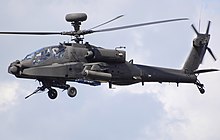
Somerset
[edit]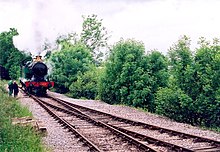
Screwfixis in Yeovil, andClarks shoeswithK-SwissEurope are inStreet,although most of its shoes are made in the Far East.Shepton Malletis home ofBlackthorn Ciderand theGaymer Cider Company.Dairy CrestpacksCathedral Citycheese inFrome.TheGlastonbury FestivalatPilton(nearer to Shepton Mallet than Glastonbury), off theA361,is the UK's biggest music festival.[151]

TheRoyal Marineshave alarge basefor40 Commandowest ofTaunton,with theirtraining centreatLympstone Commandoin Devon, on theAvocet Linewith its own station ofLympstoneand the A376 andRiver Exe.Attentionalin Taunton deliver audience figures forBARB.DS Smith'sWansbrough Paper MillatWatcheton the coast is the UK's largest manufacturer ofcoreboard.Fletcher Boatsmake speedboats inLangport.TePeUK (Swedish) supply toothbrushes.
Thales Defence closed its radar site (former EMI Electronics) near Wookey Hole, inSt Cuthbert Out.Thales Underwater Systems(formerPlesseyMarine) is atAbbas and Templecombe,Somerset, off the A357 towards Dorset in theBlackmore Vale,east of Yeovil.Commando Helicopter ForceatYeoviltonoperates Merlins and Wildcats (the upgraded version of theLynx).Mulberryis based atChilcomptonon the B3139, north of Shepton Mallet, in the Mendips.Cox & Coxfurnishings, is north of Frome inBerkley, Somersetoff the A361.Fox Brothersmake cloth inWellington,andRelyon(part ofSteinhoff International) make beds.
Italian defence contractorLeonardomakes helicopters atYeovil,formerly the home ofWestland Helicopters,building theAgustaWestland AW159 Wildcat.To the east of Yeovil, inHoundstone,Garador makegarage doors(part of Hörmann Group ofAmshausen,Europe's largest mechanical door manufacturer).Yeo Valley Organicis inBlagdon.Numatic International Limitedmakesvacuum cleanersinChard,andBrecknell Willis,a railway engineering company on theA30,makespantographs;ActionAid UKis in the Chard Business Centre, off the A358 in the north of Chard, near a centrifugaloil filterplant ofMann+Hummel.Dairy Crestmadebrandy buttersouth of the town inTatworth and Forton,near the meeting point of Dorset, Somerset and Devon.Ministry of Cake,owned by Greencore since December 2007 on the A3065 inStaplegrovein the west of Taunton, is the leading provider of frozen desserts to the UK foodservice industry. TheUnited Kingdom Hydrographic Officeis in Taunton.Pilgrims Choicecheddar is made by Adams Foods (formerNorth Downs Dairy) at Wincanton.Ariel Motor Companyin Crewkerne, make theAriel Atom.
Refresco Gerberin the north of Bridgwater, between the A38 and theRiver Parrett,makeSunnyD,Libby's,Innocent Drinks,Del Monte,Just JuiceandOcean Spray.

Next to theRoyal Portbury Dock,off junction 19 of the M5 on the A369 isLafargePlasterboard.Thatchers Cideris inSandford,North Somerseton theA368,two miles east of the M5. Towards Bristol Airport,Claverhammake actuation equipment for the aerospace sector inYattoninNorth Somerset,off theA370,and is part ofHamilton Sundstrand,derived from the electrical systems part ofFairey Aviation.
Wessex Water,Future plc,Buro HappoldandRotorkare inBath.Cadbury used to makeCurly Wurly,Double DeckerandCrunchieat theSomerdale Factory,Keynshamuntil Kraft closed the plant in March 2011 and moved production toSkarbimierz, Opole Voivodeshipin Poland.[152]
Wiltshire
[edit]
Nationwide Building Society,[153]Research Councils UKand fiveresearch councils,Intel Europe,and theBritish Computer Society[154]are in Swindon, as are the main offices ofHistoric England[155]and theNational Trust,[156]both housed in the formerGreat Western Railway'sSwindon Works.Allied Dunbarwas headquartered in the centre of Swindon until 1998, when bought byZurich Financial Services.InStratton St Margaret,BMWpress metal for theMini[157]at the formerPressed Steel Company,there is a majorHondamanufacturing plant(in South Marston) where theJazz,CivicandCR-Vare manufactured at Britain's second-largest car manufacturing plant;[158]nearby areZimmerUK (medical devices) andYuasaUK (automotive batteries).
The headquarters ofWHSmith,withSmiths News,is near theSchool Library Association,west of the MINI works inUpper Stratton.[159]Valero EnergyUK, who bought Texaco fromChevronin 2011, are inEldene,in the former head office ofSt Ivel;PatheonUK (pharmaceuticals, on the former site ofRoussel Uclaf) are on the B4006 inCovingham,north of Valero, in the east of Swindon.BG Automotive,on the Cheney Manor industrial estate, make gaskets on the B4006 inRodbourne;DynamaticUK are in a formerPlesseyfactory.Burmah Oilwas headquartered in the south of Swindon; Burmah boughtCastrolin 1966 (owned byBPfrom 2000).Stanley Security(former Amano Blick) is on the Techno trading estate, north of the town centre.

Near the M4 Spittleborough Roundabout, close toFreshbrook,areSynergy HealthandRWE npower;also on the Windmill Hill Business park areArval(vehicle leasingand fuel cards), andAllstar(fuel card); also nearby areCartusEurope,Catalent Pharma SolutionsUK andMAN Truck & BusUK (withNeoplanandERF); further east isWRc(the former Water Research Centre). Nearby on Lydiard Fields inLydiard TregozeisJohnson MattheyFuel Cells, which in 2002 was the world's first production site ofmembrane electrode assemblies,and next door isNeptune,who make furniture and kitchens; alsoBuildStorehave their National Self Build & Renovation Centre. Sauer-Danfoss UK provide hydraulics off theA419inDorcan,and nearby isTE ConnectivityUK (former Tyco Electronics andRaychem). TheBritish & Foreign Bible Societyis on the Delta Business Park inWestlea,nearIntergraphUK (geospatial software,owned byHexagon AB) on the other side of Westmead industrial estate, withMetric Group,the only UK manufacturer ofparking meters.Triumph International UKis inBlunsdon St Andrew.
Dysonis inMalmesbury,north of the M4.[160]Cotswold Outdoor(recommended supplier to theDofE Awardand the Scout Association) is based at theCotswold Airportnear the Gloucestershire boundary, south of Cirencester.

TrowbridgehasApetitoUK,[161]Wiltshire Farm Foods,Danone UKand their subsidiaryNumico.[162]Cereal PartnersmakeShredded WheatandShreddiesatStaverton,near Trowbridge. InDevizesis theWadworth Brewery.[163]Salisbury CathedralinSalisburyattracts many tourists.Rockhopper Explorationis in the town andNaim Audiomake hi-fi equipment.[164]Nearby,Dstlis atPorton Down.[165]Knorr-Bremse Rail Systems UK(formerly Westinghouse) makerailway air brakesin Bowerhill[166]just south ofMelkshamand nearby are the headquarters ofAvon Rubber[167]andHerman MillerUK, a maker of office furniture.Chippenhamhas the HQ ofWincanton plc,the large logistics company,[168]Invensys Rail Group(formerlyWestinghouse Rail Systems) who makerail signalling equipment,[169]and the software companySCISYS.
In the centre of the county are many military establishments, notablyMoD Boscombe Down,the training sites onSalisbury Plainand atMoD Lyneham,and the army bases aroundTidworth,Larkhill(home of theRoyal School of Artillery) andWarminster(HQ of theInfantry).[170]
Subdivisions
[edit]The region covers much of the historical area ofWessex(omitting onlyHampshireandBerkshire), and all of the Celtic Kingdom ofDumnoniawhich comprised Cornwall, Devon, and parts of Somerset and Dorset. In terms of local government, it was divided after 1974 intoAvon,Cornwall,Devon,Dorset,Gloucestershire,Somerset, andWiltshire.Avon has since been abolished, and several mainly urban areas have becomeunitary authorities.
Local government
[edit]The official region consists of the following geographic counties and local government areas:
| Map | Ceremonial county | Non-metropolitan county or unitary authority | Non-metropolitan districts |
|---|---|---|---|
 |
Somerset | 1.Bath and North East SomersetUA | |
| 2.North SomersetUA | |||
| 10.SomersetUA | |||
| Bristol | 3.BristolUA | ||
| Gloucestershire | 4.South GloucestershireUA | ||
| 5.Gloucestershire CC | a)Gloucester,b)Tewkesbury,c)Cheltenham,d)Cotswold,e)Stroud,f)Forest of Dean | ||
| Wiltshire | 6.SwindonUA | ||
| 7.Wiltshire UA | |||
| Dorset | 8.DorsetUA | ||
| 9.Bournemouth, Christchurch and PooleUA | |||
| Devon | 11.Devon CC | a)Exeter,b)East Devon,c)Mid Devon,d)North Devon,e)Torridge,f)West Devon,g)South Hams,h)Teignbridge | |
| 12.TorbayUA | |||
| 14.PlymouthUA | |||
| Cornwall | 15.Isles of Scillysui generisUA | ||
| 13.Cornwall UA | |||
UA =unitary authority CC =county council
Eurostat NUTS
[edit]In theEurostatNomenclature of Territorial Units for Statistics(NUTS), South West England is a level-1 NUTS region, coded "UKK", which is subdivided as follows:
| NUTS 1 | Code | NUTS 2 | Code | NUTS 3 | Code |
|---|---|---|---|---|---|
| South West England | UKK | Gloucestershire,WiltshireandBristol/Batharea | UKK1 | Bristol | UKK11 |
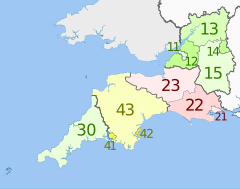
|
Bath and North East Somerset,North SomersetandSouth Gloucestershire | UKK12 | |||
| GloucestershireCC | UKK13 | ||||
| Swindon | UKK14 | ||||
| Wiltshire | UKK15 | ||||
| DorsetandSomerset | UKK2 | BournemouthandPoole | UKK21 | ||
| DorsetCC | UKK22 | ||||
| Somerset | UKK23 | ||||
| CornwallandIsles of Scilly | UKK3 | CornwallandIsles of Scilly | UKK30 | ||
| Devon | UKK4 | Plymouth | UKK41 | ||
| Torbay | UKK42 | ||||
| DevonCC | UKK43 | ||||
South West Regional Assembly
[edit]
Although referendums had been planned on whether elected assemblies should be set up in some of the regions, none was planned in the South West. TheSouth West Regional Assembly(SWRA) was theregional assemblyfor the South West region, established in 1999. It was based inExeterandTaunton.The SWRA was a partnership of councillors from all local authorities in the region and representatives of various sectors with a role in the region's economic, social and environmental well-being. There was much opposition to the formation of the SWRA with critics saying it was an unelected unrepresentative and unaccountable "quango". The Regional Assembly was wound up in May 2009, and its functions taken on by theStrategic Leaders' Board(SLB) of South West Councils.[171]
Politics
[edit]As of the2024 United Kingdom general election,The South West contains 58 seats in theHouse of Commons.Labourhold 24 seats, TheLiberal Democratshold 22 seats, TheConservativeshold 11 seats and TheGreenshold 1 seat.
Education
[edit]Schools
[edit]Secondary education
[edit]The South West has a below average rate of attainment in GCSE (and equivalent) examinations, with the lowest regional performance in England from 2009 to 2012.[172]In 2012,South Hamshad the highest percentage of pupils achieving 5 or more GCSEs at grade A*-C at 86%, whilstPurbeckhad the lowest at 70%.[173]
The region has an above average rate of attainment in A-Level (and equivalent) examinations, having outperformed theWest Midlands,East Midlands,North EastandLondonin 2012.[172]
Further education
[edit]There are around 29further educationcolleges in the region.[174]
Higher education
[edit]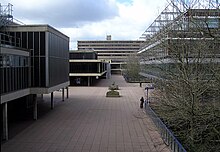
There are twelve universities in the region:
- Arts University Bournemouth[175]
- Bournemouth University[176]
- Bath Spa University[177]
- University of Bath[178]
- University of Bristol[179]
- Camborne School of Mines.[180]Part of the University of Exeter.
- University of Exeter[181]
- Falmouth University[182]
- University of Gloucestershire[183]
- The University of Law[184]
- University of Plymouth[185]
- Plymouth Marjon University[186]
- Royal Agricultural University[187]
- University of the West of England(UWE)[188]
There are also four higher education colleges. The region has the lowest number of people registered on higher education courses at FE colleges.
The University of Bristol receives the most total funding, according toHigher Education Funding Council for Englandfigures for the 2006/2007 academic year, and the largest research grant—twice as big as any other in the region.[189]Bath has the next largest research grant, closely followed by Exeter. UWE and Plymouth get small research grants, but no other universities in the region receive much of a research grant. The University of Plymouth has the largest teaching grant.
Of the region's students (postgraduate and undergraduate), 50% are from the region, and around 40% from other regions. For full-time first degree students, 35% come from the region, around 22% are fromSouth East England,and 8% are from London. Including theEast of England,around 70% are fromSouthern England.10% are from theMidlands,and 5% fromNorthern England.The main access for students from the north is theCross Country Route.Around 33% of native South West students stay in the region, with 18% going to the South East (around 60% stay in the south of England). Around 14% go to Wales, but very few go to the East of England. Access by road or rail to the East of England region is not straightforward, with around the same amount of travel as to Scotland. Many more native South West students are prepared to go to the north of England, than northern students are prepared to study in the South West. Once graduated, around 50% stay in the region, with 15% each going to London or the South East (around 80% find work in the south of England). Very few go elsewhere (especially the north of England); around 4% go to the West Midlands or Wales.[citation needed]
Local media
[edit]
Television
[edit]- BBC South West,based inPlymouthwith theSpotlightregional programme.
- BBC West,based inCliftonin Bristol with thePoints Westregional programme.
- ITV West Country,based in Bristol (following the merger ofITV WestandITV Westcountry), with theITV News West Countryregional programme.
Parts of Wiltshire and Dorset, including the Swindon, Salisbury, Bournemouth, Poole, Dorchester and Weymouth areas, receiveBBC SouthandITV MeridianfromSouthampton.
Radio
[edit]BBC Local Radioservices in the region includeCornwall,Devon,Somerset,Bristol,Wiltshire,andGloucestershire,along withBBC Radio Solent's partial opt-out service for Dorset.
Commercial radio stations include:
- Heart West,owned byGlobal,broadcasts a regional weekday programme for the South West, as well as localised news on frequencies previously occupied byHeart West Country(Bristol/Bath),Heart Devon,Heart Gloucestershire,Heart Wiltshire,andAtlantic FM(Cornwall).
- Greatest Hits Radio South West,owned byBauer,occupies a number of frequencies previously broadcast as part ofThe Breeze network.As on Heart, one regional weekday afternoon programme for the wider region is retained alongside local news and advertising. A version of GHR for Cornwall is provided on DAB and online. The formerSpire FM(Salisbury), andWessex FM(Dorchester) broadcast as part ofGreatest Hits Radio Southin a similar manner.
- Bauer Radio also operates, as of September 2021:
- Hits Radioservices forBristol(formerlySam FM) andBournemouth(previouslyFire Radio); each has a local afternoon drivetime programme, taking Hits Radio Network content at other times including breakfast.
- Kiss(national service, formerlyKiss 101for the Severn Estuary region).
- Pirate FM(Cornwall), which has retained much of its local identity and programming.
- Radio Exe(formerly Exeter FM) is an independent locally-run commercial station for Exeter. The station expanded to servePlymouthvia theDAB digital radioplatform in March 2022.[190]
- Licensed community radio services in the region includeBCfm(Bristol),Soundart Radio(Totnes),FromeFM(Somerset),Gloucester FM,Phonic FM(Exeter),Somer Valley FM(north Somerset),Radio St Austell Bay(Cornwall),Ujima Radio(Bristol),The Voice (North Devon),East Devon Radio(formerly ExmouthAiR and Bay FM), andCross Rhythms Plymouth.
National radio is transmitted fromNorth Hessary Tor(west Devon) andWenvoe(west of Cardiff).
Newspapers
[edit]Regional newspapers include theBath Chronicle,Bristol Post,Western Daily Press,theDorset Echo,theExeter Express and Echo,Western Morning News,theNorth Devon Journal,Cornish Guardian,The West Briton(Truro),The Cornishman,Wiltshire Times(Trowbridge),Gazette and Herald(North & West Wiltshire),Gloucestershire Echo,Gloucester Citizen,Plymouth Herald,Torquay Herald Express,Swindon Advertiserand theSalisbury Journal.
Sport
[edit]Rugby
[edit]Inrugby union,the region has fourPremiership Rugbyteams:Bath Rugby,Bristol Bears,Exeter ChiefsandGloucester Rugby.
Inrugby league,the region has one club,Cornwall RLFC,playing inRFL League 1.
Football
[edit]The region for two seasons until the conclusion of 2021–22 had noPremier Leagueteam since the relegation ofAFC Bournemouthin 2020.[191]During the 2016/17 season, the region had seven teams in theEnglish Football League:Bristol City,Bristol Rovers,Cheltenham,Exeter,Plymouth Argyle,Swindon,andYeovil.In the 2017/18 season they were joined byForest Green Rovers.[192]
Other teams play in the South divisions of theSouthern League,at levels 7 and 8 of theleague system.At levels 9 and 10, theWestern Leaguecovers the whole region except the most eastern parts, while theHellenic Leagueextends into Gloucestershire and north Wiltshire, and theWessex Leaguehas teams from east Dorset and south Wiltshire. Also at level 10, theSouth West Peninsula Leaguehas teams from Cornwall and Devon.
References
[edit]- ^ab"Standard Area Measurements (Latest) for Administrative Areas in the United Kingdom".Open Geography Portal.Office for National Statistics. 24 April 2024.Retrieved6 May2024.
- ^abPark, Neil (21 December 2022)."Estimates of the population for the UK, England, Wales, Scotland and Northern Ireland".Office for National Statistics.Retrieved25 August2023.
- ^abUK Census(2021)."2021 Census Area Profile – South West Region (E12000009)".Nomis.Office for National Statistics.Retrieved14 August2023.
- ^Fenton, Trevor (25 April 2023)."Regional gross value added (balanced) per head and income components".Office for National Statistics.Retrieved14 August2023.
- ^Fenton, Trevor (25 April 2023)."Regional gross domestic product: all ITL regions".Office for National Statistics.Retrieved15 August2023.
- ^"South West Regional Assembly, Draft Regional Spatial Strategy for the South West, para.1.1.1"(PDF).Archived(PDF)from the original on 4 March 2012.Retrieved24 May2012.
- ^"South West Regional Assembly, Draft Regional Spatial Strategy for the South West, paras.1.1.3 and 7.2.1"(PDF).Archived(PDF)from the original on 4 March 2012.Retrieved24 May2012.
- ^"Information Sheet 1E: The Dartmoor granite and associated igneous rocks"(PDF).Dartmoor National Park Authority.Archived(PDF)from the original on 15 November 2009.Retrieved9 September2009.
- ^"High Willhays".Peakbagger.Archivedfrom the original on 19 January 2012.Retrieved9 September2009.
- ^"Direct From Dorset Producer case study".Western Gazette.This is Dorset. 16 January 2009.Retrieved9 September2009.
- ^abWilliams, Robin; Williams, Romey (1992).The Somerset Levels.Bradford on Avon: Ex Libris Press.ISBN0-948578-38-6.
- ^Duff, K.L.; McKirdy, A.P.; Harley, M.J. (1985).New sites for old: A students guide to the geology of the east Mendips.Nature Conservancy Council.ISBN0-86139-319-8.
- ^"Dorset and East Devon Coast".UNESCO World Heritage Centre. 2001.Archivedfrom the original on 24 October 2012.Retrieved14 January2007.
- ^abcd"South West England: climate".Met Office.Archived fromthe originalon 5 June 2011.Retrieved14 March2010.
- ^"South west faces temperature jump".BBC News.19 June 2009.Retrieved25 June2009.
- ^Sandford, Mark."The Cornish Question: Devolution in the South-West Region"(PDF).UCL.Archived(PDF)from the original on 21 February 2011.Retrieved12 February2011.
- ^"Regional Spaces: Spaces of Regionalism, Territory, Insurgent Politics and the English Question".Scribd. 31 March 2009.Archivedfrom the original on 18 January 2012.Retrieved24 May2012.
- ^Cornish Constitutional Convention."Campaign for a Cornish Assembly".Cornishassembly.org.Archivedfrom the original on 10 March 2012.Retrieved24 May2012.
- ^"Population".South West RDA.Archivedfrom the original on 4 September 2009.Retrieved9 September2009.
- ^Harris, Nigel (2008). "Taking trains back to Tavistock".Rail.No. 590. Peterborough. pp. 40–45.
- ^"UK storms destroy railway line and leave thousands without power".BBC News.5 February 2014.Archivedfrom the original on 5 February 2014.Retrieved5 February2014.
- ^"Dawlish's storm-damaged railway line reopens".BBC News.4 April 2014.Archivedfrom the original on 4 April 2014.Retrieved4 April2014.
- ^"Network Rail chooses Dawlish alternative route".BBC News.10 February 2014.Archivedfrom the original on 11 February 2014.Retrieved10 February2014.
- ^ "The LTP Process".Department for Transport.Archived fromthe originalon 13 May 2010.Retrieved26 September2010.
- ^ "Bournemouth 2006–11 Local Transport Plan".Bournemouth Borough Council.Archived fromthe originalon 15 April 2009.Retrieved28 April2009.
- ^"Cornwall 2006–11 Local Transport Plan".Cornwall Council.Archivedfrom the original on 4 August 2009.Retrieved28 April2009.
- ^"Devon 2006–11 Local Transport Plan".Devon County Council.Archivedfrom the original on 11 November 2009.Retrieved28 April2009.
- ^"Dorset 2006–11 Local Transport Plan".Dorset County Council.Archivedfrom the original on 11 October 2007.Retrieved28 April2009.
- ^"Gloucestershire 2006–11 Local Transport Plan".Gloucestershire County Council.Archivedfrom the original on 7 October 2007.Retrieved28 April2009.
- ^"Plymouth 2006–11 Local Transport Plan".Plymouth City Council.Archivedfrom the original on 26 July 2008.Retrieved28 April2009.
- ^"Somerset 2006–11 Local Transport Plan".Somerset County Council.Archivedfrom the original on 9 January 2009.Retrieved28 April2009.
- ^"Swindon 2006–11 Local Transport Plan".Swindon Borough Council.Archivedfrom the original on 1 May 2009.Retrieved28 April2009.
- ^"Torbay 2006–11 Local Transport Plan".Torbay Borough Council.Archivedfrom the original on 15 August 2007.Retrieved28 April2009.
- ^"Wiltshire 2006–11 Local Transport Plan".Wiltshire Council.Archivedfrom the original on 10 September 2010.Retrieved28 April2009.
- ^ "West of England Partnership 2011–26 Local Transport Plan".West of England Partnership. Archived fromthe originalon 24 October 2010.Retrieved28 April2009.
- ^"Mendip Hills An Archaeological Survey of the Area of Outstanding Natural Beauty"(PDF).Somerset County Council Archeological Projects.Archived(PDF)from the original on 16 May 2011.Retrieved8 November2010.
- ^"Earliest British cemetery dated"(PDF).BBC News.Archived(PDF)from the original on 6 February 2007.Retrieved27 January2007.
- ^abDunning, Robert (1983).A History of Somerset.Chichester: Phillimore & Co.ISBN0-85033-461-6.
- ^"Cheddar Man".RN-DS Partnership.Archived fromthe originalon 11 June 2008.Retrieved18 April2008.
- ^ab"Historical Monitoring in the Somerset Levels and Moors ESA 1987–1994"(PDF).DEFRA.Archived fromthe original(PDF)on 26 September 2007.Retrieved10 June2007.
- ^Adkins, Lesley; Adkins, Roy (1992).A field guide to Somerset archeology.Wimborne: Dovecote Press. pp. 69–70.ISBN978-0-946159-94-9.
- ^"British Tribes".From Dot to Domesday.Archivedfrom the original on 22 January 2008.Retrieved2 December2007.
- ^"Britannia in the Ravenna Cosmography".cyberhome of Keith Fitzpatrick-Matthews.Archivedfrom the original on 15 March 2007.Retrieved2 December2007.
- ^[1]Archived17 February 2017 at theWayback MachineLanguage in the British Isles, Peter Trudgill, 1984
- ^Rajan, Amal (24 August 2007)."Around a county in 40 facts: A (very) brief history of Somerset".Independent on Sunday.London. Archived fromthe originalon 14 February 2009.Retrieved21 October2007.
- ^Havinden, Michael (1981).The Somerset Landscape.The making of the English landscape. London: Hodder and Stoughton. p. 979.ISBN0-340-20116-9.
- ^"Romano-British Somerset".Somerset County Council: History of Somerset.Archived fromthe originalon 17 October 2012.Retrieved29 October2006.
- ^"Roman Baths Treatment Centre".Images of England.Archived fromthe originalon 15 June 2009.Retrieved15 November2006.
- ^abRoss, Lesley, ed. (2004).Before the Lake: Memories of the Chew Valley.The Harptree Historic Society.ISBN0-9548832-0-9.
- ^Hucker, Ernest (1997).Chew Stoke Recalled in Old Photographs.Ernest Hucker.
- ^"The West Bagborough Hoard".Newsletter Spring/Summer 2003.Somerset Archaeological and Natural History Society.Archived fromthe originalon 17 July 2011.Retrieved10 July2010.
- ^"Huge Roman coin find for hobbyist".BBC News.8 July 2010.Retrieved8 July2010.
- ^Booth, Anna (8 July 2010)."The Frome Hoard".Portable Antiquities Scheme.Archived fromthe originalon 12 July 2010.Retrieved8 July2010.
- ^Pearce, Susan M. (1978),The Kingdom of Dumnonia: Studies in History and Tradition in South-Western Britain A.D. 350–1150Padstow: Lodenek Press.
- ^Stenton, F. M. (1971).Anglo-Saxon England(3rd ed.). Oxford: Clarendon Press. p. 30.ISBN978-0-19-280139-5.
- ^Morris, John(1973).The Age of Arthur.London: Phoenix. p. 299.ISBN1-84212-477-3.
- ^The Anglo-Saxon Chronicle,501–97 ADArchived10 November 2006 at theWayback Machine.
- ^The Anglo-Saxon Chronicle,645–56 ADArchived12 December 2007 at theWayback Machine
- ^The Anglo-Saxon Chronicle,658–75 ADArchived12 December 2007 at theWayback Machine
- ^The Victoria History of the County of Somerset,Vol 1 (1906)South West England
- ^"Roman Times".Britannia.Archived fromthe originalon 12 November 2006.Retrieved29 October2006.
- ^Scott, Shane (1995).The hidden places of Somerset.Aldermaston: Travel Publishing Ltd. p. 16.ISBN1-902007-01-8.
- ^Pearson, Michael (2003).Kennet & Avon Middle Thames: Pearson's Canal Companion.Rugby: Central Waterways Supplies.ISBN0-907864-97-X.
- ^Charles Oman."History of Taunton Castle in Somerset".Britannia castles.Archived fromthe originalon 31 May 2008.Retrieved21 November2007.
- ^The Cornish hill is usually accepted as the location mentioned in an entry in theAnglo-Saxon Chroniclefor 835 (corrected by scholars to 838) which says thatEgbertking of theWest Saxonsdefeated an army ofVikingsandCornishatHengestdun= "Stallion Hill". See, for example:Higham, Robert (2008).Making Anglo-Saxon Devon.Exeter: The Mint Press. p. 64.ISBN978-1-903356-57-9..However, Hingston Down in Devon has also been proposed as the site.
- ^Shipley Duckett, Eleanor (1956).Alfred the Great: The King and His England.University of Chicago Press.pp.73–74.ISBN0-226-16779-8.
- ^Payton, Philip(1996).Cornwall.Fowey: Alexander Associates
- ^Todd, MalcolmThe South West to AD 1000.London, 1987; p. 289
- ^abFarr, Grahame (1954).Somerset Harbours.London: Christopher Johnson. pp. 125–137.
- ^"Replicas of the Alfred Jewel".The Anglo Saxon Index, Trinity College, Cambridge.Archived fromthe originalon 2 November 2007.Retrieved18 September2007.
- ^"Local History".North Petherton.Archivedfrom the original on 30 June 2007.Retrieved19 November2007.
- ^Rahtz, Philip."The Saxon and Medieval Palaces at Cheddar, Somerset-an Interim Report of Excavations in I 960-62"(PDF).Archaeology Data Service.Archived(PDF)from the original on 10 April 2008.Retrieved31 March2008.
- ^Blair, Peter Hunter (2003).An Introduction to Anglo-Saxon England(3rd ed.). Cambridge University Press. p. 98.ISBN0-521-53777-0.Archivedfrom the original on 18 February 2017.Retrieved17 March2016.
- ^The Anglo-Saxon ChronicleArchived20 March 2018 at theWayback Machine.LondonL J. M. Dent, 1912. Translation byJames Ingram(London, 1823) andJ. A. Giles(London, 1847). Medieval and Classical Literature Library Release #17. Retrieved 4 May 2018.
- ^Lapidge, Michael (2001). "Swein Forkbeard",The Blackwell Encyclopaedia of Anglo-Saxon England.Ed. Michael Lapidge, John Blair, et al. London: Blackwell Publishing; p. 437.ISBN0-631-15565-1.
- ^Barlow, Frank(1970).Edward the Confessor.Berkeley, CA: University of California Press. pp.29–36.ISBN0-520-01671-8.
- ^"Eadmund".Archontology.org.Archivedfrom the original on 27 September 2010.Retrieved5 July2010.
- ^"Saxon Times".Britannia.Archivedfrom the original on 12 November 2006.Retrieved29 October2006.
- ^"Bridgwater Castle, Bridgwater".Somerset Historic Environment Record.Somerset County Council.Archivedfrom the original on 3 October 2016.Retrieved12 October2008.
- ^"The history of Exmoor".Exmoor National Park.Archived fromthe originalon 29 July 2013.Retrieved29 November2007.
- ^Lawrence, J.F. (revised and completed by Lawrence, J.C.) (2005).A History of Bridgwater.Chichester: Phillimore.ISBN1-86077-363-X.Chapter 8: "The Medieval Port of Bridgwater".
- ^Farr, Grahame (1954).Somerset Harbours.London: Christopher Johnson. p. 104.ISBN0-900131-15-2.
- ^Dunning, Robert (1992b).Bridgwater: History and Guide.Stroud: Alan Sutton. p. 193.ISBN0-7509-0192-6.
- ^Dunning, Robert (1992b).Bridgwater: History and Guide.Stroud: Alan Sutton. p. 193.ISBN0-7509-0192-6.
- ^Brace, Keith (1996).Portrait of Bristol.London: Robert Hale. pp. 13–15.ISBN0-7091-5435-6.
- ^Croxton, Derek (1990–1991)."The Cabot Dilemma: John Cabot's 1497 Voyage & the Limits of Historiography".Essays in History.33.Virginia: Corcoran Department of History at the University of Virginia.Archivedfrom the original on 28 February 2009.Retrieved16 March2009.
- ^"Largest towns in England in 1334".Love my town.Archivedfrom the original on 11 May 2011.Retrieved10 March2007.
- ^ab"Bristol".Fortified Places.Archivedfrom the original on 20 March 2007.Retrieved24 March2007.
- ^Stansfield-Cudworth, R.E. (2009).Political Elites in South-West England, 1450–1500: Politics, Governance and the Wars of the Roses.Lewiston, New York:Edwin Mellen Press.pp. 149–89, 191–225, 303–45.ISBN978-0-77344-714-1.
- ^Heal, Felicity (2003).Reformation in Britain and Ireland,p. 225. Oxford University Press.ISBN0-19-826924-2.
- ^Secor, Philip Bruce (1999).Richard Hooker: Prophet of Anglicanism,p. 13. Continuum International Publishing Group.ISBN0-86012-289-1.
- ^Willen, Diane (Autumn 1975). "Lord Russell and the Western Counties, 1539–1555".The Journal of British Studies.15(1): 26–45.doi:10.1086/385677.S2CID162954069.
- ^Bryant, Edward; Haslett, Simon (2002). "Was the AD 1607 coastal flooding event in the Severn estuary and Bristol channel due to a Tsunami?".Archaeology in the Severn Estuary.13:163–167.
- ^Bryant, Edward; Haslett, Simon (2004). "The AD 1607 Coastal Flood in the Bristol Channel and Severn Estuary: Historical Records from Devon and Cornwall (UK)".Archaeology in the Severn Estuary.15:81–89.
- ^"Historic Buildings of Shepton Mallet".Shepton Mallet Town Council.Archived fromthe originalon 18 January 2012.Retrieved30 August2007.
- ^Disney, Francis (1992).Shepton Mallet Prison (2nd Ed).Published by the Author.ISBN0-9511470-2-1.
- ^Rodgers, Colonel H.C.B. (1968).Battles and Generals of the Civil Wars.Seeley Service & Co.
- ^"Taunton's History".Taunton Town Centre!.Archived fromthe originalon 3 June 2007.Retrieved21 November2007.
- ^"The Civil War in Somerset".Somerset County Council: History of Somerset.Archived fromthe originalon 25 September 2006.Retrieved29 October2006.
- ^"The Monmouth rebellion and the bloody assize".Somerset County Council.Archivedfrom the original on 29 August 2007.Retrieved11 February2008.
- ^"History of Bridgwater".Bridgwater.Archivedfrom the original on 12 November 2007.Retrieved21 October2007.
- ^"Tudor & Stuart Times".Britannia.Archivedfrom the original on 12 November 2006.Retrieved29 October2006.
- ^J. Childs,The Army, James II, and the Glorious Revolution(Manchester, 1980)
- ^"Devonport".Royal Navy.Archivedfrom the original on 22 September 2013.Retrieved17 July2012.
- ^Day, Lance; McNeil, Ian (1998).Biographical Dictionary of the History of Technology.Taylor & Francis. p. 678.ISBN0-415-19399-0.
- ^"Chard was there first".Daily Telegraph.London. 7 October 2006. Archived fromthe originalon 29 October 2006.Retrieved17 October2008.
- ^"North Petherton".British History Online.Archivedfrom the original on 25 May 2011.Retrieved19 November2007.
- ^Awdry, Christopher(1990).Encyclopaedia of British Railway Companies.Patrick Stephens Ltd. p. 19.ISBN978-1-85260-049-5.
- ^Smith, Martin (1992).The Railways of Bristol & Somerset.Sherton: Ian Allan Publishing. p. 96.ISBN978-0-7110-2063-4.
- ^"City of Bristol (Portishead Docks) Act".Office of Public Sector Information. 1992.Archivedfrom the original on 25 September 2008.Retrieved1 December2009.
- ^Slapton Line: Slapton Monument RededicationArchived31 May 2016 at theWayback Machine– Devon County Council – Devon.gov.uk – Updated 9 March 2007
- ^Stokes, Paul. "Veterans honour 749 who died in D-Day rehearsal" –The Daily Telegraph – London– 29 April 1994
- ^John Penny MA; The Luftwaffe over the Bristol area 1940–44Archived11 May 2011 at theWayback MachineRetrieved 14 July 2008
- ^Cocroft, Wayne D. (2000).Dangerous Energy: The archaeology of gunpowder and military explosives manufacture.Swindon: English Heritage.ISBN1-85074-718-0
- ^"Taunton Stop Line".Pillboxes Somerset.Archived fromthe originalon 28 October 2007.Retrieved25 October2007.
- ^"The Mendip Society website".Archivedfrom the original on 5 February 2007.Retrieved17 February2007.
- ^"Hinkley A: 1965".BBC Somerset.BBC.Archivedfrom the original on 18 July 2006.Retrieved5 July2008.
- ^"New dawn for UK nuclear power".World Nuclear News. 24 September 2008.Archivedfrom the original on 25 September 2008.Retrieved25 September2008.
- ^"Nuclear energy: British Energy facts".The Daily Telegraph.London. 24 September 2008.Archivedfrom the original on 27 September 2008.Retrieved25 September2008.
- ^"Ethnic group - Office for National Statistics".ons.gov.uk.Retrieved29 November2022.
- ^"Ethnic group - Office for National Statistics".ons.gov.uk.Retrieved29 November2022.
- ^the South West GovOf through time | Population Statistics | Total PopulationArchived12 October 2012 at theWayback Machine.Visionofbritain.org.uk. Retrieved on 14 March 2021
- ^As UK Census data past 2001 is unavailable through the ONS website, it has beenrecommendedto use archival census collection websites. Data is from theUK Data Service,1991 Census on Ethnic Data for England(Table 6)
- ^"Office of National Statistics; 2001 Census Key Statistics".webarchive.nationalarchives.gov.uk.Retrieved24 June2022.
- ^"2011 Census: Ethnic Group, local authorities in England and Wales".webarchive.nationalarchives.gov.uk.Retrieved24 June2022.
- ^"Ethnic group - Office for National Statistics".ons.gov.uk.Retrieved29 November2022.
- ^"TS030 - Religion Edit query".nomisweb.co.uk.Retrieved29 November2022.
- ^"KS209EW (Religion) - Nomis - 2011".nomisweb.co.uk.Retrieved18 October2022.
- ^"KS007 - Religion - Nomis - 2001".nomisweb.co.uk.Retrieved18 October2022.
- ^"Disappointment as teen pregnancies increase".This is South Devon. 20 June 2009.Retrieved9 September2009.
- ^"Deprivation indices 2007"(PDF).Archived fromthe original(PDF)on 9 June 2012.Retrieved24 May2012.
- ^"Index of Multiple Deprivation (IMD) 2007".Data.gov. 9 February 2010.Archivedfrom the original on 27 January 2013.Retrieved9 February2013.
- ^"Changing Regional Economies — South West"(PDF).Office for National Statistics.Archived(PDF)from the original on 16 September 2012.Retrieved17 July2012.
- ^Jackson, Kenneth (1953).Language and History in Early Britain.Edinburgh: Edinburgh University Press.
- ^Payton, PhilipCornwall.Fowey: Alexander Associates (1996).
- ^"The Cornish Language".Kernowek.Archivedfrom the original on 19 September 2012.Retrieved9 February2013.
- ^Gover, J.; Mawer, A. and Stenton, F. M.Place-Names of Devon,1932
- ^abcd"Portrait of South West England: Economy".Eurostat&Office for National Statistics,2004.Archivedfrom the original on 11 March 2007.Retrieved14 April2006.
- ^"Economy Module".Economy.swo.org.uk. Archived fromthe originalon 25 May 2012.Retrieved24 May2012.
- ^"Tourism contribution figures".South West Regional Development Agency.Archivedfrom the original on 12 June 2007.Retrieved16 June2007.
- ^Office of the Deputy Prime Minister, 2004. "Competitive European Cities: Where do the Core Cities stand? Urban Research Summary 13Archived30 October 2005 at theWayback Machine."Page 12 (PDF)
- ^"Manufacturing Advisory Service".Mas.bis.gov.uk.Archivedfrom the original on 27 December 2011.Retrieved24 May2012.
- ^"UKTI".UKTI.Archivedfrom the original on 15 June 2012.Retrieved24 May2012.
- ^"Regional, sub-regional and local Gross Value Added 2010"(PDF).Statistical Bulletin.Office for national Statistics. 14 December 2011. p. 10.Archived(PDF)from the original on 4 May 2012.Retrieved9 June2012.
- ^"The changing state of the south west 2012".South West Observatory.Archivedfrom the original on 28 April 2012.Retrieved17 July2012.
- ^"Objective One in Cornwall and the Isles of Scilly".The Partnership Office for Cornwall and the Isles of Scilly.Archivedfrom the original on 1 July 2012.Retrieved9 June2012.
- ^"Local Authority & County Analysis 2006–2010".GBTS England LA & County & Towns 2006–2010.VisitEngland. September 2011. p. 5.Retrieved9 June2012.
- ^"Objective One in Cornwall and the Isles of Scilly".objectiveone.Archivedfrom the original on 1 July 2012.Retrieved7 June2012.
- ^Richard Norton-Taylor (10 June 2003)."The Doughnut, the less secretive weapon in the fight against international terrorism".The Guardian.Archivedfrom the original on 19 December 2013.Retrieved15 December2013.
- ^V&A (2022)."V&A · The history of Glastonbury Festival".Victoria and Albert Museum.Retrieved22 October2022.
- ^Kelly, Chris (14 January 2011)."Broken chocolate factory pledge devastates Keynsham".BBC News.Archivedfrom the original on 28 May 2011.Retrieved21 October2017.
- ^"Locations of our head offices".Nationawide.Archivedfrom the original on 30 December 2017.Retrieved30 December2017.
- ^"Details of our Swindon and London Offices".BCS.Archivedfrom the original on 30 December 2017.Retrieved30 December2017.
- ^"Swindon National Office".Historic England.Archivedfrom the original on 30 December 2017.Retrieved30 December2017.
- ^"Heelis".National Trust.Archivedfrom the original on 30 December 2017.Retrieved30 December2017.
- ^"Mini Plant Swindon".MINI.Archivedfrom the original on 14 November 2017.Retrieved30 December2017.
- ^"Honda boosts UK investment".BBC.Archivedfrom the original on 31 August 2007.Retrieved30 December2017.
- ^"Head Office – Swindon".WH Smith.Archivedfrom the original on 30 December 2017.Retrieved30 December2017.
- ^"Malmesbury".Dyson.Archivedfrom the original on 30 December 2017.Retrieved30 December2017.
- ^"Our History".Apetito.Archivedfrom the original on 30 December 2017.Retrieved30 December2017.
- ^"Contact Us".Danone.Archivedfrom the original on 30 December 2017.Retrieved30 December2017.
- ^"Visit Us".Wadworths.Archivedfrom the original on 30 December 2017.Retrieved30 December2017.
- ^"Contact Information".Naim. 3 September 2014.Archivedfrom the original on 30 December 2017.Retrieved30 December2017.
- ^"dstl".dstl.Archivedfrom the original on 29 December 2017.Retrieved30 December2017.
- ^"Contact Information".Knorr-Bremse.Archivedfrom the original on 30 December 2017.Retrieved30 December2017.
- ^"Where We Operate".Avon Rubber.Archivedfrom the original on 30 December 2017.Retrieved30 December2017.
- ^"Contact".Wincanton PLC.Archivedfrom the original on 30 December 2017.Retrieved30 December2017.
- ^Armstrong, Julie (8 May 2013)."£1.8bn takeover of Invensys Rail in Chippenham concluded".Gazette and Herald.Archivedfrom the original on 30 December 2017.Retrieved30 December2017.
- ^"Salisbury Plain Training Area (SPTA)".Army.Archivedfrom the original on 30 December 2017.Retrieved30 December2017.
- ^SW Councils (17 May 2012)."Strategic Leaders' Board".Swcouncils.gov.uk.Archivedfrom the original on 8 February 2011.Retrieved24 May2012.
- ^abEducation and Skills In Your Area - EnglandArchived12 February 2014 at theWayback MachineDfE
- ^Education and Skills In Your Area - South West RegionArchived21 February 2014 at theWayback MachineDfE
- ^"Further Education Finder".findfe.Archivedfrom the original on 2 February 2014.Retrieved20 January2014.
- ^"Arts University Bournemouth".Arts University Bournemouth.Archivedfrom the original on 15 May 2018.Retrieved2 January2016.
- ^"Bournemouth University".Bournemouth University. Archived fromthe originalon 26 January 2015.Retrieved2 January2016.
- ^"Bath Spa University".Bath Spa University. Archived fromthe originalon 9 December 2007.Retrieved2 January2016.
- ^"University of Bath".University of Bath.Archivedfrom the original on 1 January 2016.Retrieved2 January2016.
- ^"University of Bristol".University of Bristol.Archivedfrom the original on 1 January 2016.Retrieved2 January2016.
- ^"Camborne School of Mines".Retrieved23 April2020.
- ^"University of Exeter".University of Exeter.Archivedfrom the original on 31 December 2015.Retrieved2 January2016.
- ^"Falmouth University".Falmouth University.Archivedfrom the original on 2 January 2016.Retrieved2 January2016.
- ^"University of Gloucestershire".University of Gloucestershire.Archivedfrom the original on 28 November 2004.Retrieved2 January2016.
- ^"University of Law".University of Law.Archivedfrom the original on 29 December 2015.Retrieved2 January2016.
- ^"Plymouth University".Plymouth University.Archivedfrom the original on 10 January 2016.Retrieved2 January2016.
- ^"University of St Mark & St John".University of St Mark & St John.Archivedfrom the original on 26 December 2015.Retrieved2 January2016.
- ^"Royal Agricultural University".Royal Agricultural University.Archivedfrom the original on 26 December 2015.Retrieved2 January2016.
- ^"University of the West of England".University of the West of England.Archivedfrom the original on 2 January 2016.Retrieved2 January2016.
- ^"South West Region"(PDF).Regional profiles of higher education 2007.HEFCE.Archived(PDF)from the original on 12 November 2009.Retrieved31 March2010.
- ^Radio Exe, 2022-03-04
- ^Richards, Alex (26 July 2020)."Premier League relegation: Watford and Bournemouth down as Aston Villa safe after final day".Mirror.Retrieved29 November2020.
- ^""Forest Green Rovers: The village team that reached the English Football League",BBC News,15 May 2017 ".BBC Sport.Archivedfrom the original on 14 January 2018.Retrieved14 February2018.
Further reading
[edit]- Brayshay, Mark (1986).Topographical Writers in South-West England.Exeter: University of Exeter Press.ISBN0-85989-424-X.
- Dunning, Robert (1983).A History of Somerset.Chichester: Phillimore & Co.ISBN0-85033-461-6.
- Higham, Robert (1989).Landscape and Townscape in the South-West.Exeter: University of Exeter Press.ISBN0-85989-309-X.
- Stansfield-Cudworth, R.E. (2009).Political Elites in South-West England, 1450–1500.Lewiston, New York:Edwin Mellen Press.ISBN978-0-77344-714-1.
- Pearce, Susan (2004).South-Western Britain in the Early Middle Ages.London: Leicester University Press.ISBN0-71850-055-5.
- Todd, Malcolm (1987).The South West to AD 1000.London: Routledge.ISBN0-58249-274-2.








